The 3D Printed Universe
We offer two kinds of 3D printable objects in this section. The first is a set of specially-developed fully 3D models, and the second is a set of tactile plates that are developed as relief maps of images to help make the 2D data more experiential.
Explore the models by year:
This tactile plate pair (see immediately below for second plate) shows two physical relief maps, both based on the intensity of Chandra X-ray data, featuring Cassiopeia A, a filled donut-shaped supernova remnant located about 11,000 light-years from Earth. Included in the plates is the main plate, featuring the full object and showing the inset region, and an inset closeup plate, which highlights a region with relative abundances of silicon and neon.
Over three hundred years ago, Cassiopeia A, or Cas A, was a star on the brink of self-destruction. In composition it resembled an onion with layers rich in different elements such as hydrogen, helium, carbon, silicon, sulfur, calcium, and neon, wrapped around an iron core. When that iron core grew beyond a certain mass, the star could no longer support its own weight. The outer layers fell into the collapsing core, then rebounded as a supernova. This explosion created the filled donut-like shape shown in the main plate. The shape is somewhat irregular, with the thinner quadrant of the donut to the upper left of the off-center hole.
In the body of the donut, shown in the main plate, the remains of the star’s elements create a mottled cloud of texture, marbled with spidery veins. Here, the mottled regions represent sulfur, calcium and iron. Some of the tangles of veins are silicon, and other veins, which also line the outer edge of the donut-shape, are the highest-energy X-rays detected by Chandra and show the explosion’s blast wave. A raised box denotes the region featured in the other (inset) plate.
The inset plate highlights a close-up, mottled region at the thinner, upper left quadrant of Cas A. Here, rich pockets of silicon and neon are identified by labels. New evidence from Chandra indicates that in the hours before the star’s collapse, part of a silicon-rich layer traveled outward, and broke into a neighboring neon-rich layer. This violent breakdown of layers created strong turbulent flows, and may have promoted the development of the supernova’s blast wave, facilitating the star’s explosion. Additionally, upheaval in the interior of the star may have produced a lopsided explosion, resulting in the irregular shape, with an off-center hole (and a thinner bite of donut!) at our upper left.
Download the Cassiopeia A Plate STL file
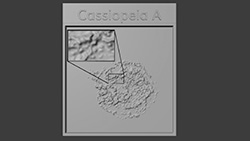
3D Print Credit: NASA/CXC/A. Jubett, using software by Tactile Universe/N. Bonne & C. Krawczyk & Blender
This tactile plate pair (see immediately above for second plate) shows two physical relief maps, both based on the intensity of Chandra X-ray data, featuring Cassiopeia A, a filled donut-shaped supernova remnant located about 11,000 light-years from Earth. Included in the plates is the main plate, featuring the full object and showing the inset region, and an inset closeup plate, which highlights a region with relative abundances of silicon and neon.
Over three hundred years ago, Cassiopeia A, or Cas A, was a star on the brink of self-destruction. In composition it resembled an onion with layers rich in different elements such as hydrogen, helium, carbon, silicon, sulfur, calcium, and neon, wrapped around an iron core. When that iron core grew beyond a certain mass, the star could no longer support its own weight. The outer layers fell into the collapsing core, then rebounded as a supernova. This explosion created the filled donut-like shape shown in the main plate. The shape is somewhat irregular, with the thinner quadrant of the donut to the upper left of the off-center hole.
In the body of the donut, shown in the main plate, the remains of the star’s elements create a mottled cloud of texture, marbled with spidery veins. Here, the mottled regions represent sulfur, calcium and iron. Some of the tangles of veins are silicon, and other veins, which also line the outer edge of the donut-shape, are the highest-energy X-rays detected by Chandra and show the explosion’s blast wave. A raised box denotes the region featured in the other (inset) plate.
The inset plate highlights a close-up, mottled region at the thinner, upper left quadrant of Cas A. Here, rich pockets of silicon and neon are identified by labels. New evidence from Chandra indicates that in the hours before the star’s collapse, part of a silicon-rich layer traveled outward, and broke into a neighboring neon-rich layer. This violent breakdown of layers created strong turbulent flows, and may have promoted the development of the supernova’s blast wave, facilitating the star’s explosion. Additionally, upheaval in the interior of the star may have produced a lopsided explosion, resulting in the irregular shape, with an off-center hole (and a thinner bite of donut!) at our upper left.
Download the Cassiopeia A Plate STL file
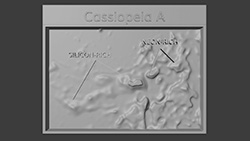
3D Print Credit: NASA/CXC/A. Jubett, using software by Tactile Universe/N. Bonne & C. Krawczyk & Blender
This tactile plate features a composite image of MSH 15-52, a nebula and pulsar that resembles a cosmic hand reaching for a cloud. Chandra’s X-ray view is combined with radio data from ATCA, as well as optical data of hydrogen gas. A cloud sits near the top of the plate, just to our right of center. Breaks in the cloud reveal interwoven strands like a latticework substructure. The cloud is the remains of the supernova that formed the pulsar at the heart of the image. The pulsar, a rapidly spinning neutron star only 12 miles in diameter, is far too small to be seen in this image, which represents a region of space over 150 light-years across. The bottom half of the plate is dominated by a massive hand reaching up toward the pulsar and supernova cloud. The hand and nebula are set against the blackness of space, surrounded by scores of specks. At our lower left, a hydrogen gas cloud extends beyond the edges of the image.
Download the MSH 15-52 Plate STL file
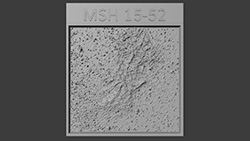
3D Print Credit: NASA/CXC/A. Jubett, using software by Tactile Universe/N. Bonne & C. Krawczyk & Blender
This tactile plate is a physical relief map based on the intensity of Chandra X-ray data along with other wavelengths of light from different telescopes.
The spiral galaxy known as NGC 2146 is shown here from the side. The galaxy resembles a streaky, tilted disk of puckered cloud with a less-distinct haze at the center.
Download the NGC 2146 Plate STL file
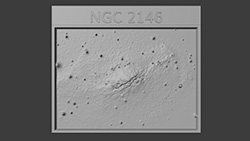
3D Print Credit: NASA/CXC/A. Jubett, using software by Tactile Universe/N. Bonne & C. Krawczyk & Blender
This tactile plate is a physical relief map based on the intensity of Chandra X-ray data along with other wavelengths of light from different telescopes.
N79 is a giant star forming region in the Large Magellanic Cloud. Here, ridged shafts of light bursting out of a central raised orb cut through misty web-like clouds.
Download the N79 Plate STL file
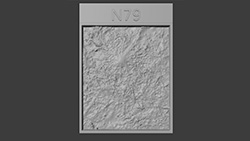
3D Print Credit: NASA/CXC/A. Jubett, using software by Tactile Universe/N. Bonne & C. Krawczyk & Blender
This tactile plate is a physical relief map based on the intensity of Chandra X-ray data along with other wavelengths of light from different telescopes.
The spiral galaxy known as NGC 2146 is shown here from the side. The galaxy resembles a streaky, tilted disk of puckered cloud with a less-distinct haze at the center.
Download the NGC 2146 Plate STL file

3D Print Credit: NASA/CXC/A. Jubett, using software by Tactile Universe/N. Bonne & C. Krawczyk & Blender
This tactile plate is a physical relief map based on the intensity of Chandra X-ray data along with other wavelengths of light from different telescopes.
IC 348 is a star-forming region in our Milky Way galaxy. This other-worldly image resembles a tangle of hair dotted with dozens of raised orbs in various sizes.
Download the IC 348 Plate STL file
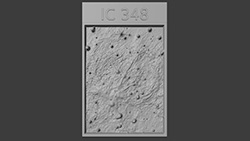
3D Print Credit: NASA/CXC/A. Jubett, using software by Tactile Universe/N. Bonne & C. Krawczyk & Blender
This tactile plate is a physical relief map based on the intensity of Chandra X-ray data along with other wavelengths of light from different telescopes.
M83 is a spiral galaxy. Here, the disk-shaped galaxy is viewed face-on, with mottled arms spiraling around a central protruding core.
Download the M83 Plate STL file
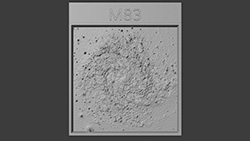
3D Print Credit: NASA/CXC/A. Jubett, using software by Tactile Universe/N. Bonne & C. Krawczyk & Blender
This tactile plate is a physical relief map based on the intensity of Chandra X-ray data along with other wavelengths of light from different telescopes.
In this plate, the tilted, disk-shaped M82 starburst galaxy is viewed edge-on. Bursting out of the core in opposite directions, perpendicular to the disk, are giant, hazy gas clouds that extend for thousands of light-years.
Download the M82 Plate STL file
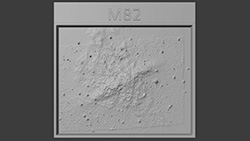
3D Print Credit: NASA/CXC/A. Jubett, using software by Tactile Universe/N. Bonne & C. Krawczyk & Blender
This tactile plate is a physical relief map based on the intensity of Chandra X-ray data along with other wavelengths of light from different telescopes.
NGC 1068 is a relatively nearby spiral galaxy. This neighbor is viewed face-on, with its tightly packed arms and faint clouds swirling around a hazy bump of a core. There, million-mile-per-hour winds swirl around a glowing black hole.
Download the NGC 1068 Plate STL file
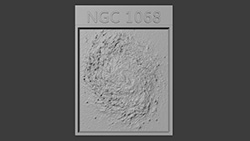
3D Print Credit: NASA/CXC/A. Jubett, using software by Tactile Universe/N. Bonne & C. Krawczyk & Blender
This tactile plate is a physical relief map based on the intensity of Chandra X-ray data along with other wavelengths of light from different telescopes.
NGC 346, a cluster of newborn stars, is depicted here by hundreds of spiky dots, and thousands of tightly-packed tiny specks, that together fill up a billowy cloud.
Download the NGC 346 Plate STL file
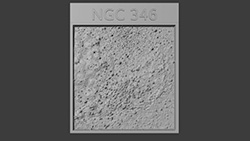
3D Print Credit: NASA/CXC/A. Jubett, using software by Tactile Universe/N. Bonne & C. Krawczyk & Blender
This tactile plate is a physical relief map based on the intensity of Chandra X-ray data along with other wavelengths of light from different telescopes.
IC 1623 is a system where two galaxies are in the process of merging. Backed by tendrils, swirls of specks, and gauzy ribbons, two plateaued clusters meet, sending out starlike rays of light.
Download the IC 1623 Plate STL file
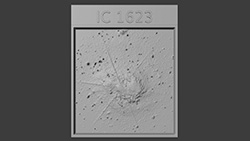
3D Print Credit: NASA/CXC/A. Jubett, using software by Tactile Universe/N. Bonne & C. Krawczyk & Blender
This tactile plate is a physical relief map based on the intensity of Chandra X-ray data along with other wavelengths of light from different telescopes.
Westerlund 1 is Earth's biggest and closest neighboring "super" star cluster. Here, scores of bumpy orbs and tiny specks pack the otherwise empty space, surrounded by a haze, and mottled clouds.
Download the Westerlund 1 Plate STL file
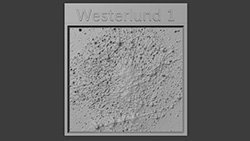
3D Print Credit: NASA/CXC/A. Jubett, using software by Tactile Universe/N. Bonne & C. Krawczyk & Blender
This tactile plate is a physical relief map based on the intensity of Chandra X-ray data, featuring a small bump, which represents a dim star, closely orbited by a Jupiter-sized planet. Astronomers used the Chandra data to measure the amount of X-rays striking the planet from the star. They estimate that the planet is losing a mass equivalent to a full Earth’s atmosphere about every 200 years, causing it to ultimately shrink from the size of Jupiter down to a small, barren world.
Download the TOI 1227 b Plate STL file
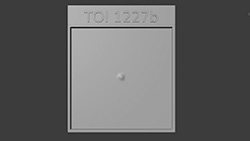
3D Print Credit: NASA/CXC/A. Jubett, using software by Tactile Universe/N. Bonne & C. Krawczyk & Blender
This tactile plate is a physical relief map based on the intensity of Chandra X-ray data along with radio, infrared, optical and ultraviolet data, featuring the Andromeda galaxy, our closest spiral galaxy neighbor. The multiwavelength data helps astronomers understand the evolution of the Milky Way, our own spiral galaxy, and provides a fascinating insight into astronomical data gathering and presentation.
Like all spiral galaxies observed at this distance and angle, Andromeda appears relatively flat. Its spiraling arms circle around a raised core, creating a bulging disk shape, like a large dinner plate. Andromeda’s flat surface is tilted to face our upper left.
This plate features data from some of the world’s most powerful telescopes, each capturing light in a different spectrum. In each single-spectrum wavelength, Andromeda has a similar shape and orientation, but the details are dramatically different.
In radio waves, the spiraling arms present like a loosely coiled rope. The center features no discernible radio core. In infrared light, the outer arms are similarly protruding. But here, a spiraling ring encircles a puffy center with a small infrared core. The optical data is hazy, with spiraling arms like faint smoke rings. Here, the vastness of space is dotted with points of light, and a small dot contributes to the multiwavelength bump of the core of the galaxy. In ultraviolet light the spiraling arms are also evident, with a ball at the core. No spiral arms are present in the X-ray data, which is most concentrated at the core.
Download the Andromeda Galaxy, M31 Plate STL file
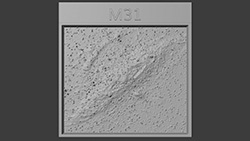
3D Print Credit: NASA/CXC/A. Jubett, using software by Tactile Universe/N. Bonne & C. Krawczyk & Blender
This tactile plate is a physical relief map based on the intensity of Chandra X-ray data along with optical data from PanSTARRS and radio data from MeerKAT, featuring a cloud of energetic particles surrounding a distant galaxy cluster. The galaxy cluster, known as PLCK G287, sits at the center of the plate; a collection of raised dots flecked with hundreds of similar specks. Surrounding the cluster is an X-ray cloud. This gradated cloud spans about five million light years.
Flanking the cloud at our upper right and lower left are wispy bands — giant shockwaves, relics detected by earlier studies of radio waves in the region. The band at our lower left is somewhat smaller and more clearly defined, while the shockwave at our upper right is larger, and abuts the central raised cloud.
Download the PLCK G287.0+32.9 Plate STL file
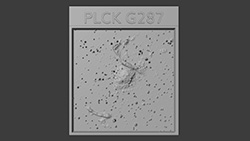
3D Print Credit: NASA/CXC/A. Jubett, using software by Tactile Universe/N. Bonne & C. Krawczyk & Blender
This tactile plate is a physical relief map based on the intensity of Chandra X-ray data, featuring a black hole, located 11.6 billion light-years from Earth. Near this black hole, the leftover glow from the big bang, known as the cosmic microwave background or CMB, is much denser than it is now.
As electrons in jets blast away from the black hole, they move through the sea of CMB radiation. The electrons boost the energies of the CMB light into the X-ray band, allowing the jets to be detected by Chandra, even at this great distance.
The raised object on the plate depicts this interaction. Here, a circular plateau is ringed with a band of energy. The jet is the less distinct raised line shooting off that ring, aimed toward our upper right, with a blob of energy at its tip.
Download the J1610+1811 (labeled) Plate STL file
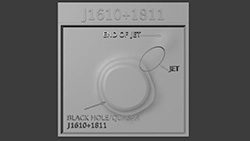
3D Print Credit: NASA/CXC/A. Jubett, using software by Tactile Universe/N. Bonne & C. Krawczyk & Blender
This tactile plate is a physical relief map based on the intensity of Chandra X-ray & XMM-Newton data along with optical and radio data, featuring a dramatic cosmic story unfolding 2.8 billion light years from Earth: the fallout when two galaxy clusters collide. At the center of the plate are the colliding galaxy clusters, which together are known as PSZ2 G181. This combined cluster somewhat resembles an irregular peanut shell, with bulbous ends linked by a tapered middle. Inside each bulbous end are several raised dots; some of the galaxies within the clusters. The peanut shape is tilted at a slight angle, surrounded by a cloud of X-ray gas. Far from the bulbous ends, at our upper left and lower right, are two blotchy, thick lines. These are probably shock fronts, similar to those created by jets that have broken the sound barrier. Bracketing the combined galaxy cluster, these shock fronts were caused by the initial collision about a billion years ago. They are currently separated by 11 million light-years. New data from the Chandra and XMM-Newton observatories suggests that PSZ2 G181 is poised for another powerful cosmic event. Having already taken one swipe at each other, the two clusters within are once again on a collision course.
Download the PSZ2 G181 Plate STL file
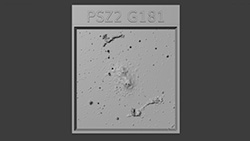
3D Print Credit: NASA/CXC/A. Jubett, using software by Tactile Universe/N. Bonne & C. Krawczyk & Blender
This tactile plate is a physical relief map based on the intensity of Chandra X-ray data along with radio and infrared data, featuring a mysterious object, possibly an unusual neutron star or white dwarf, residing near the edge of a supernova remnant. The object, known as ASKAP J1832, has been intriguing with its antics and bizarre behavior.
Astronomers working with the Square Kilometre Array Pathfinder radio telescope have discovered that ASKAP J1832 cycles in radio wave intensity every 44 minutes. This is thousands of times longer than pulsars, which are rapidly spinning neutron stars that have repeated variations multiple times a second. Using Chandra, the team discovered that the object is also regularly varying in X-rays every 44 minutes. This is the first time such an X-ray signal has been found in a long period radio transient like ASKAP J1832.
In the tactile plate, the curious object ASKAP J1832 is shown in the context of the supernova remnant and nearby gas clouds. The supernova remnant is the large, wispy, semi-circular oval ring sweeping across the lower right quadrant of the image. ASKAP J1832 sits inside this ring, to our right of center; a tiny point-like speck in a sea of other specks. The gas cloud largely occupying the upper left quadrant depicts infrared data from NASA’s Spitzer Space Telescope.
A labeled version of the tactile plate features a fine, raised circle to denote the location of ASKAP J1832.
Download the ASKAP J1832−0911 (without circle) Plate STL file
Download the ASKAP J1832−0911 (without circle) Loop Plate GLB file
Download the ASKAP J1832−0911 (without circle) Loop Plate OBJ file
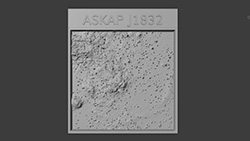
3D Print Credit: NASA/CXC/A. Jubett, using software by Tactile Universe/N. Bonne & C. Krawczyk & Blender
This labeled version of the tactile plate is a physical relief map based on the intensity of Chandra X-ray data along with radio and infrared data, featuring a mysterious object, possibly an unusual neutron star or white dwarf, residing near the edge of a supernova remnant. The object, known as ASKAP J1832, has been intriguing with its antics and bizarre behavior. A fine, raised circle on this plate denotes the location of ASKAP J1832.
Astronomers working with the Square Kilometre Array Pathfinder radio telescope have discovered that ASKAP J1832 cycles in radio wave intensity every 44 minutes. This is thousands of times longer than pulsars, which are rapidly spinning neutron stars that have repeated variations multiple times a second. Using Chandra, the team discovered that the object is also regularly varying in X-rays every 44 minutes. This is the first time such an X-ray signal has been found in a long period radio transient like ASKAP J1832.
In the tactile plate, the curious object ASKAP J1832 is shown in the context of the supernova remnant and nearby gas clouds. The supernova remnant is the large, wispy, semi-circular oval ring sweeping across the lower right quadrant of the image. ASKAP J1832 sits inside this ring, to our right of center; a tiny point-like speck in a sea of other specks. The gas cloud largely occupying the upper left quadrant depicts infrared data from NASA’s Spitzer Space Telescope.
Download the ASKAP J1832−0911 (with circle) Plate STL file
Download the ASKAP J1832−0911 (with circle) Loop Plate GLB file
Download the ASKAP J1832−0911 (with circle) Loop Plate OBJ file
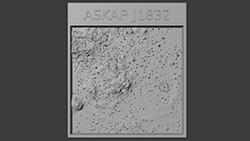
3D Print Credit: NASA/CXC/A. Jubett, using software by Tactile Universe/N. Bonne & C. Krawczyk & Blender
This tactile plate is a physical relief map based on the intensity of X-ray and infrared data. In this composite plate, a prominent, massive star, WR 124, sits like a snowflake in the center of 6 diffraction spikes, surrounded by a churning wind cloud. The combination of the wind cloud with the spikes, dots and tangles of wisps resembles a puffy dandelion that has gone to seed. Dozens of other prominent stars surround WR 124, including dots rimmed with mounds of light, and other dots with raised diffraction spikes. The mounded dots are stars detected with Chandra.
Download the WR 124 Plate STL file
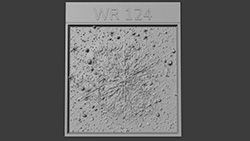
3D Print Credit: NASA/CXC/A. Jubett, using software by Tactile Universe/N. Bonne & C. Krawczyk & Blender
This tactile plate is a physical relief map based on the intensity of X-ray and optical data. In this composite plate, a supermassive black hole at the center of the Centaurus A galaxy shoots an enormous jet of particles into a star-packed sky. Here, Centaurus A resembles layers of streaky clouds. At the heart of the combined cloud structure is the black hole, a protruding dot that lights the clouds from within. The jet emerges from this dot, a speckled beam shooting toward our upper left. Surrounding the entire galaxy is a bubble shape, which is most pronounced at our lower right. This bubble was created by the jets from the black hole. Both the jets and the bubble are detected by Chandra.
Download the Centaurus A Plate STL file
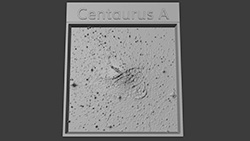
3D Print Credit: NASA/CXC/A. Jubett, using software by Tactile Universe/N. Bonne & C. Krawczyk & Blender
This tactile plate is a physical relief map based on the intensity of X-ray data (from Chandra, IXPE and XMM-Newton) along with radio and infrared data, featuring a binary star system at the center of a supernova remnant known as the Manatee Nebula. The raised, puffy area does resemble a bulbous walrus or manatee, floating in less dense haze packed with distant specks. Inside the nebula lie a couple of streaks and a large raised dot. The dot is the binary system at the heart of the puffy nebula.
Download the SS 433 Plate STL file
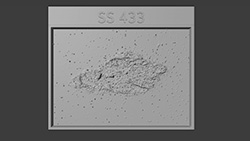
3D Print Credit: NASA/CXC/A. Jubett, using software by Tactile Universe/N. Bonne & C. Krawczyk & Blender
This tactile plate is a physical relief map based on the intensity of Chandra X-ray data along with radio data from MeerKAT, featuring a long, thin, cosmic structure. With the structure’s vertical orientation, seemingly fragile thin dimensions, and raised ridge against the vast empty immediate area of space, the plate resembles a medical X-ray of a long, thin, bone. The structure, called G359.13, or “The Snake”, is a Galactic Center Filament. These filament formations are threaded by parallel magnetic fields, and spiraling, energized particles. The particles cause radio waves, which can be detected by radio arrays, in this case by the MeerKAT array in South Africa.
The largely straight filament stretches from the top to the bottom of the plate. At each end of the filament is a hazy cloud. The plate is sparsely dotted with a few specks surrounding the structure. These specks represent X-rays detected by NASA’s Chandra X-ray Observatory.
One such speck appears to be interacting with the structure itself. This is a fast-moving, rapidly spinning neutron star, otherwise known as a pulsar. Astronomers believe that this pulsar has struck the filament halfway down its length, distorting the magnetic field and radio signal. This distortion resembles a small break, or spur, in the bone-like filament.
Download The Bone Plate STL file
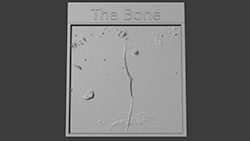
3D Print Credit: NASA/CXC/A. Jubett, using software by Tactile Universe/N. Bonne & C. Krawczyk & Blender
This tactile plate features a physical relief map of the supernova remnant Cygnus Loop, based on the intensity of X-ray light from NASA's Chandra X-ray Observatory, and Optical light from a ground based telescope by astrophotographer John Stone. In the composite plate, the remnant resembles a wispy cloud, shaped like a backwards letter C. The 3D model examines this cloud of interstellar material interacting with the superheated, supernova blast wave.
Download the Cygnus Loop Plate STL file
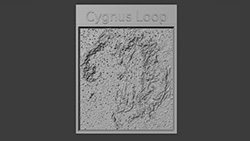
3D Print Credit: NASA/CXC/A. Jubett, using software by Tactile Universe/N. Bonne & C. Krawczyk & Blender
This tactile plate features a physical relief map of BP Tau based on the intensity of X-ray light from NASA's Chandra X-ray Observatory, and Optical light from PanSTARRS. BP Tau is a developing star, less than 10 million years old, and prone to outbursts or flares. These flares interact with a disk of material that surrounds the young star, forming hot loops of extended atmosphere. BP Tau sits at the very center of the plate, and resembles a distant, raised dot surrounded by a band of ribbon.
Download the BP Tau Plate STL file
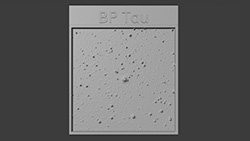
3D Print Credit: NASA/CXC/A. Jubett, using software by Tactile Universe/N. Bonne & C. Krawczyk & Blender
This tactile plate depicts supernova remnant G292.0+1.8, as a physical relief map based on the intensity of the X-ray data captured by NASA's Chandra X-ray Observatory and Optical data from DSS. The composite image depicts the remnant as a bumpy and intricate ball of X-ray gas and debris set against a backdrop of bright stars. The G292.0+1.8 supernova remnant contains a pulsar moving at over a million miles per hour. Pulsars are rapidly spinning neutron stars that can form when massive stars run out of fuel, collapse, and explode. Sometimes these explosions produce a “kick,” which sent this pulsar racing through the remains of the supernova explosion.
Download the G292.0+1.8 Plate STL file
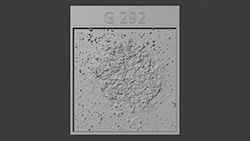
3D Print Credit: NASA/CXC/A. Jubett, using software by Tactile Universe/N. Bonne & C. Krawczyk & Blender
This tactile plate features a physical relief map of Cassiopeia A based on the intensity of X-ray light from NASA's Chandra, Infrared light from NASA's Webb and Spitzer, and Optical light from NASA's Hubble. The resulting tactile plate of Cassiopeia A resembles a disk of electric light with clouds and streaks. An area near the center of the remnant resembles a somewhat circular region of lightning. X-rays from Chandra reveal hot gas, mostly from supernova debris from the destroyed star, and include elements like silicon and iron. X-rays are also present as thin arcs in the outer regions of the remnant. Data from Webb highlights infrared emission from dust that is warmed up because it is embedded in the hot gas detected by Chandra, and from much cooler supernova debris. Hubble data shows a multitude of stars that dot the field of view.
Download the Cassiopeia A Plate STL file
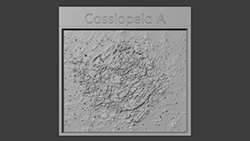
3D Print Credit: NASA/CXC/A. Jubett, using software by Tactile Universe/N. Bonne & C. Krawczyk & Blender
This tactile plate is a physical relief map based on the intensity of Chandra X-ray data along with optical, ultraviolet, and infrared data, featuring the Helix Nebula, a cloud of gas ejected by a dying star known as a white dwarf. In the plate, the shape of the cloud of gas strongly resembles a creature’s eye. Here, a hazy cloud is surrounded by undulating, concentric rings. Each ring appears dusted with sequins, particularly the outer edges of the eye-shape.
The entire image is speckled with raised dots. At the center of the hazy gas cloud, in a field of relative calm, lies a prominent dot, which represents the central white dwarf. An illustrated box surrounds the white dwarf, calling attention its location.
Download the Helix Nebula Plate STL file
Download the Helix Nebula Plate GLB file
Download the Helix Nebula Plate OBJ file
Download the Helix Nebula with Illustrated Box Plate STL file
Download the Helix Nebula with Illustrated Box Plate GLB file
Download the Helix Nebula with Illustrated Box Plate OBJ file
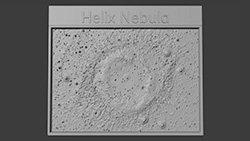
3D Print Credit: NASA/CXC/A. Jubett, using software by Tactile Universe/N. Bonne & C. Krawczyk & Blender
This tactile plate is a physical relief map based on the intensity of Chandra X-ray data along with optical, radio and infrared data, featuring a highly detailed composite image of a star-forming region of space known as 30 Doradus, shaped like a bouquet, or a maple leaf.
30 Doradus is a powerful stellar nursery. In 23 days of observation, the Chandra X-ray telescope revealed thousands of distinct star systems. Chandra data also revealed a diffuse X-ray glow from winds blowing off giant stars, and X-ray gas expelled by exploding stars, or supernovas.
In this plate, the X-ray wind and gas takes the shape of a massive encompassing bouquet with an extended central flower, or perhaps a leaf from a maple tree. The slightly-raised, mottled shape occupies much of the image, positioned just to our left of center, tilted slightly to our left. Inside the gas and wind cloud are ridges of veins, and pockets of protruding bumps. The pockets of bumps represent clusters of young stars. One cluster at the heart of 30 Doradus houses the most massive stars astronomers have ever found.
The overall bouquet is surrounded by pointy dots. A second mottled cloud shape, which resembles a ring of smoke, sits in our lower righthand corner.
In a second tactile plate, relief-map labels point out three key features: Star Cluster R136, roughly in the center of the bouquet shape, Supernova N157B, central from left to right and close to the bottom of the plate, and Superbubble 30 Dor C, the “ring of smoke” mentioned above.
Download the 30 Doradus Plate STL file
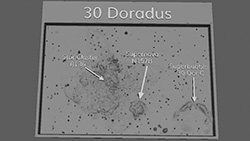
3D Print Credit: NASA/CXC/A. Jubett, using software by Tactile Universe/N. Bonne & C. Krawczyk & Blender
This tactile plate is a physical relief map based on the intensity of Chandra X-ray data along with optical and infrared data, featuring a galaxy cluster, known as Centaurus, with a central black hole surrounded by patches and filaments of gas.
In this plate, a raised patch with distinct veins floats in the emptiness of space, surrounded by small dots representing flecks of light. At the center of the patch is a pronounced dot representing a black hole. The raised patch represents hot X-ray gas, and the veins represent filaments of warm gas. According to a new model published, jets from the black holes impact the hot X-ray gas. This gas cools into warm filaments, with some warm gas flowing back into the black hole. The return flow of warm gas causes jets to again cool the hot gas, triggering the cycle once again.
Download the Centaurus Galaxy Cluster Plate STL file
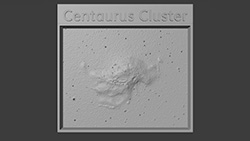
3D Print Credit: NASA/CXC/A. Jubett, using software by Tactile Universe/N. Bonne & C. Krawczyk & Blender
This tactile plate is a physical relief map based on the intensity of Chandra X-ray data along with optical and infrared data, featuring a galaxy cluster, known as Perseus, with a central black hole surrounded by patches and filaments of gas.
In this plate, a raised patch with distinct veins floats in the emptiness of space, surrounded by small dots representing flecks of light. At the center of the patch is a pronounced dot representing a black hole. The raised patch represents hot X-ray gas, and the veins represent filaments of warm gas. According to a new model published, jets from the black holes impact the hot X-ray gas. This gas cools into warm filaments, with some warm gas flowing back into the black hole. The return flow of warm gas causes jets to again cool the hot gas, triggering the cycle once again.
Download the Perseus Galaxy Cluster Plate STL file
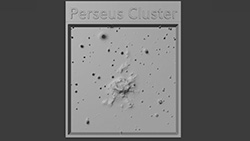
3D Print Credit: NASA/CXC/A. Jubett, using software by Tactile Universe/N. Bonne & C. Krawczyk & Blender
This tactile plate is a physical relief map based on the intensity of Chandra X-ray and Webb infrared data, featuring a star cluster that strongly resembles the shape of a holiday wreath.
The cluster includes a giant dust cloud ring, filling up the edges of the plate. The bumpy, textured torus shape and feathery edges of the ring cloud create the shape of a wreath made of evergreen boughs. Smoother raised parts of the “wreath” representing X-rays, highlight layers within the wreath-like ring cloud.
The image is teeming with specks and dots, representing stars within the cluster. Some of the dots gleam with asterisk-shaped diffraction spikes, while others are surrounded by a sloped area. Upon closer inspection, many of the specks have spiraling arms, indicating that they are, in fact, distant galaxies.
Download the NGC 602 Plate STL file
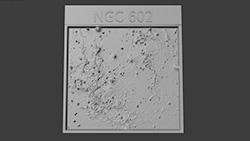
3D Print Credit: NASA/CXC/A. Jubett, using software by Tactile Universe/N. Bonne & C. Krawczyk & Blender
This tactile plate is a physical relief map based on the intensity of Chandra X-ray and Palomar optical data, featuring what can be described as a giant flame-throwing guitar floating in space.
The guitar shape appears at our lower left, with the neck of the instrument pointing toward our upper left. The guitar shape is ghostly and soft in texture, resembling a wispy cloud on a dark night. At the end of the neck, the guitar’s headstock comes to a sharp point that lands on a prominent dot. This dot is a pulsar, and the guitar shape is a hydrogen nebula. The nebula was formed when particles being ejected by the pulsar produced a cloud of bubbles. The bubbles were then blown into a curvy guitar shape by a steady wind. The guitar shape is undeniable, and is enhanced by an added, thin raised outline.
The pulsar, known as PSR B2224+65, has also released a long filament of energetic matter and antimatter particles approximately 12 trillion miles long. The X-ray blast shoots from the large dot at the tip of the guitar’s headstock, all the way out to our upper righthand corner. The blast resembles a streak of raised dots, most of which fall in a straight, densely packed line.
Download the Guitar Nebula Plate STL file
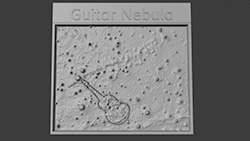
3D Print Credit: NASA/CXC/A. Jubett, using software by Tactile Universe/N. Bonne & C. Krawczyk & Blender
This tactile plate is a physical relief map based on the intensity of X-ray and infrared data, featuring the Cygnus OB2 star cluster, which resembles a night sky blanketed in hazy fog and feathery clouds.
The center of the plate is dominated by raised hazy lumps, smoother than the more speckled edges. These hazy lumps represent diffuse X-ray emissions, and young stars, detected by the Chandra X-ray observatory. Surrounding the haze is a mottled, streaky, raised cloud. Another raised cloud stretches from the lower left to the center of the plate. These clouds represent relatively cool dust and gas observed by the Spitzer Space Telescope.
Download the Cygnus OB2 Plate STL file
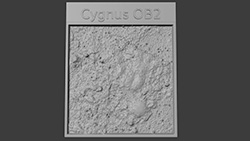
3D Print Credit: NASA/CXC/A. Jubett, using software by Tactile Universe/N. Bonne & C. Krawczyk & Blender
This tactile plate is a physical relief map based on the intensity of X-ray and Optical data, depicting two pairs of hot gas tails found inside a single galaxy cluster in the X-ray data from Chandra. This plate is presented unlabeled and labeled.
Mottled gas speckles a region of space dotted with distant flecks. Also present in this region of space are several larger dots. These dots are individual galaxies that together form the cluster Zwicky 8338.
To our right of center is a galaxy with a mottled V shaped cloud above it. Labels identify the two arms of the V as tails trailing behind the hurtling galaxy below.
To our left of center is another raised bump of a galaxy, this one surrounded by gas. Behind it, opening toward our right in the shape of a widening V lying on its side, are two more mottled clouds. These newly-discovered gas tails are even larger than the previously discovered tails. These tails, which overlap with the galaxy on our right, are over 1.6 million light-years long.
Download the Zwicky 8338 Plate STL file
Download the Zwicky 8338 Plate GLB file
Download the Zwicky 8338 Plate OBJ file
Download the Zwicky 8338 (Labeled) Plate STL file
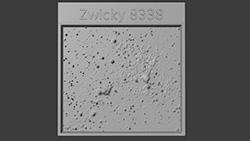
3D Print Credit: NASA/CXC/A. Jubett, using software by Tactile Universe/N. Bonne & C. Krawczyk & Blender
This tactile plate is a physical relief map based on the intensity of X-ray and optical data. In this composite plate, a large spiral galaxy has some of its superheated gas stolen by a smaller, nearby neighbor. Centered in the frame, NGC 6872 is a large spiral galaxy with two elongated arms that stretch toward our upper right and lower left. Near the raised dot at the heart of the galaxy, a cloud surrounds the arms. This cloud represents hot gas detected by Chandra. Just to the upper left of NGC 6872 is a second spiral galaxy. Its spiraling arms are much smaller, but the raised dot at its core is quite large, suggesting a supermassive black hole. Some of the matter and gas from NGC 6872’s lower arm seems to be floating toward the smaller galaxy, likely pulled toward the supermassive black hole.
Download the NGC 6872 Plate STL file
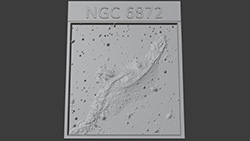
3D Print Credit: NASA/CXC/A. Jubett, using software by Tactile Universe/N. Bonne & C. Krawczyk & Blender
30 Doradus, otherwise known as the Tarantula Nebula, is a region of active star formation in a neighboring galaxy. This tactile plate depicts 30 Doradus as a physical relief map based on the intensity of X-ray data captured by the Chandra X-ray Observatory and infrared data from the James Webb Space Telescope. The file for this plate can be downloaded and 3D-printed for learners to touch.
In the plate, small specks of light and larger points of stars interact with gas clouds. The brightest and most prominent cloud of X-ray gas appears at the center of the image, roughly shaped like an upward pointing triangle. Darker X-ray clouds can be found near the right and left edges of the image. Thinner patches resembling clouds of roiling fire are the infrared light. The brightest and most prominent infrared cloud appears at the upper left, roughly shaped like a downward pointing triangle. Wispy patches outline the upward pointing bright triangle in the center of the image. Inside this frame is a very bright star with six long, thin, diffraction spikes. Beside it is a cluster of smaller bright specks showing young stars in the nebula.
Download the Tarantula Nebula Plate STL file
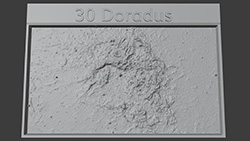
3D Print Credit: NASA/CXC/A. Jubett, using software by Tactile Universe/N. Bonne & C. Krawczyk & Blender
This tactile plate is a physical relief map based on the intensity of X-ray data from Chandra and IXPE, and optical data from Hubble. It features the remnant of a supernova explosion, which resembles a mushroom at the heart of a web of veins and filaments. Known as the Crab Nebula, the heavily veined cloud of gas fills most of the space on the plate, with the mushroom-shaped nebula at its center. At the core of the nebula is a pulsar, a rotating neutron star emitting electromagnetic radiation. Here, the pulsar presents as a raised dot sitting in the middle of the plate. Surrounding the dot are rings. These are created by particles driven away from the pulsar and colliding with gas in the nebula to produce X-rays. From this angle, the rings and cloud combine to resemble a mushroom cap. Completing the shape of a mushroom is a thin mushroom stem emerging from the dot. This is a narrow beam of particles blasting away from the pulsar.
Download the Crab Nebula Plate STL file
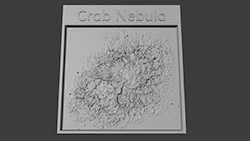
3D Print Credit: NASA/CXC/A. Jubett, using software by Tactile Universe/N. Bonne & C. Krawczyk & Blender
This tactile plate is a physical relief map based on the intensity of X-ray and infrared data. In this composite plate, a collection of points representing stars poke through a haze of wispy clouds. The young stars range in size from tiny specks to plump circles. Many have raised cores, and are surrounded by less-distinct rings, identifying stars detected by Chandra. Some display long, ruler-straight diffraction spikes. Near the upper right of the plate is a burst of cloud that resembles a thick shock of hair. Both the cloud burst and the collection of stars are smoothed by hazy clouds, as if felt through a thick piece of fabric.
Download the Orion Nebula Plate STL file
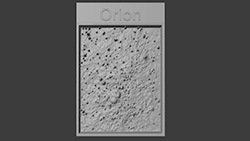
3D Print Credit: NASA/CXC/A. Jubett, using software by Tactile Universe/N. Bonne & C. Krawczyk & Blender
This tactile plate is a physical relief map based on the intensity of X-ray and optical data, featuring a pair of merging galaxies, each presenting as a raised mass, earning the pair the nickname ‘The Eyes’. Near our lower left is the galaxy NGC 4438. The most prominent dot is surrounded by a clumpy cloud of hot gas seen with Chandra. A cloud nestled in a vertical strip of haze partially blocks the regular shape of the superheated gas. At our upper right is the second galaxy, NGC 4435. This jutting dot is surrounded by a thin, raised ring. The galaxy sits in the center of a streak, at the heart of a plateaued pool. Flecks of pointed dots speckle the plate, set against the vastness of space.
Download The Eyes Galaxies (NGC 4438 & 4435) Plate STL file
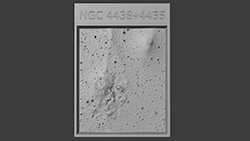
3D Print Credit: NASA/CXC/A. Jubett, using software by Tactile Universe/N. Bonne & C. Krawczyk & Blender
This tactile plate is a physical relief map based on the intensity of X-ray, infrared and optical data. In this composite plate of the Cat’s Paw nebula, clumps of clouds blanket a sky packed with stars. Throughout this star-forming region of the Milky Way, distinct pockets of clouds are linked by wispy ridges. A cluster of the brightest stars in the image are found in the heart of the nebula. Many are quite prominent, with raised dots at their core, representing young stars observed by Chandra.
Download The Cat's Paw Nebula (NGC 6334) Plate STL file
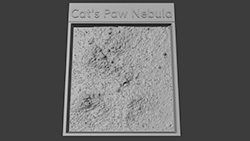
3D Print Credit: NASA/CXC/A. Jubett, using software by Tactile Universe/N. Bonne & C. Krawczyk & Blender
This tactile plate is a physical relief map based on the intensity of X-ray and radio data. The composite plate depicts the center of our Milky Way galaxy, featuring a row of spots and swirls, set against a backdrop of clouds and stars. The clouds show hot gas seen with Chandra. Threads, which are mysterious sources of radio waves, create clusters, streaks, and ribbons. Several of these distinct shapes resemble lingering spark trails from a fire. While most of the distinct swirls and spots sit in an orderly row across the middle of the plate, one very raised spot sits at our lower righthand corner, quite large in diameter. This is the area around Sagittarius C, a bright star forming region, which here resembles a mesa jutting out of the prairie.
Download The Milky Way's Galactic Center Plate STL file
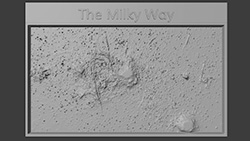
3D Print Credit: NASA/CXC/A. Jubett, using software by Tactile Universe/N. Bonne & C. Krawczyk & Blender
This tactile plate is a physical relief map based on the intensity of Chandra X-ray and Webb infrared data, featuring a region of star formation known as the Pillars of Creation. Here, tall columns of gas and dust emerge from the bottom edge of the plate, stretching toward our upper right. Backed by mist, the cloudy columns are surrounded by dozens of soft, dots of various sizes. These dots are young stars emitting X-ray and infrared light. Churning with turbulent gas and dust, the columns lean to our right with small offshoots pointing in the same direction. The mist, stars, and lifelike dust formations combine to create a row of yearning cloud creatures at dusk, reaching for something just out of frame.
Download the M16 (Eagle Nebula) Plate STL file
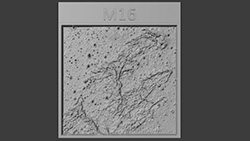
3D Print Credit: NASA/CXC/A. Jubett, using software by Tactile Universe/N. Bonne & C. Krawczyk & Blender
This tactile plate is a physical relief map based on the intensity of X-ray and optical data. In this composite plate, several stars poke through murky cloud formations. These are young stars detected by Chandra. At our lower right, a clumpy cloud rises, ridge-like, out of a muddy mist. Other clouds stretch from our lower left, to our upper right. There, near the upper righthand corner, two long indented triangles appear to burst from a central protruding star. These triangles are in fact shadows from the young star, cast on distant clouds. The eerie shape, reminiscent of the Batman call sign projected against a cloudy Gotham sky, has earned the phenomenon the nickname The Bat Shadow.
Download the Bat Shadow (Serpens Cloud) Plate STL file
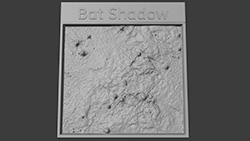
3D Print Credit: NASA/CXC/A. Jubett, using software by Tactile Universe/N. Bonne & C. Krawczyk & Blender
This tactile plate is a physical relief map based on the intensity of X-ray, infrared and optical data. This composite plate features a spiral galaxy, situated face on. Here, two speckled arms spiral around a black hole at the heart of the galaxy, known as NGC 7469. Faintly raised clouds of mist trace the lines of the speckled arms, softening the ridges in the plate. Here, the black hole at the center of the galaxy is represented by a pointed dot encircled by a mottled ring. This dot and ring represent X-ray emission from hot gas around the black hole. Due to the perfect face-on angle, six raised diffraction spikes radiate from the protruding black hole, like laser beams.
Download the NGC 7469 Plate STL file
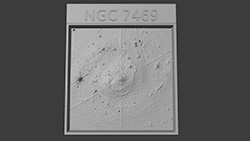
3D Print Credit: NASA/CXC/A. Jubett, using software by Tactile Universe/N. Bonne & C. Krawczyk & Blender
This tactile plate is a physical relief map based on the intensity of X-ray and optical data, featuring approximately one dozen galaxies, set against a backdrop dotted with tiny specks of light. Some of the galaxies resemble pointed, protruding dots. Other galaxies resemble disks, or have slightly raised outer rings. These galaxies are part of a galaxy cluster containing over a thousand galaxies. To our right of center is a large puffy dot surrounded by a ridged streak. This is the galaxy M86 traveling through the cluster at about three million miles per hour. The streak represents hot gas detected with Chandra. This hot gas is being pulled from the traveling galaxy as it collides with hot gas in the cluster.
Download the Virgo Cluster (including M86) Plate STL file
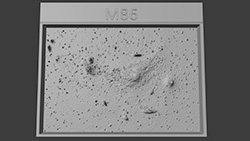
3D Print Credit: NASA/CXC/A. Jubett, using software by Tactile Universe/N. Bonne & C. Krawczyk & Blender
This tactile plate is a physical relief map based on the intensity of X-ray and infrared data. In this composite plate, a prominent, massive star, WR 124, sits like a snowflake in the center of 6 diffraction spikes, surrounded by a churning wind cloud. The combination of the wind cloud with the spikes, dots and tangles of wisps resembles a puffy dandelion that has gone to seed. Dozens of other prominent stars surround WR 124, including dots rimmed with mounds of light, and other dots with raised diffraction spikes. The mounded dots are stars detected with Chandra.
Download the WR 124 Plate STL file
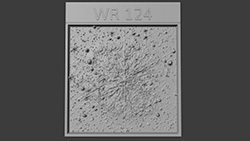
3D Print Credit: NASA/CXC/A. Jubett, using software by Tactile Universe/N. Bonne & C. Krawczyk & Blender
This tactile plate is a physical relief map based on the intensity of X-ray and radio data. The composite plate depicts a supernova remnant, which has a raised nebula at its core, surrounded by a cloud of X-rays detected with Chandra. Here, the nebula is represented by a small protruding dot at the center of the plate. The dot appears to hover inside a tangle of clumpy veins, which resemble a lightning cluster. Enveloping the nebula is the massive x-ray cloud, which occupies much of the plate. Round in shape, the diffuse X-ray cloud is shown here in mottled streaked ridges. It represents the debris from the star destroyed in the supernova explosion.
Download the Supernova Remnant G21.5-0.9 Plate STL file
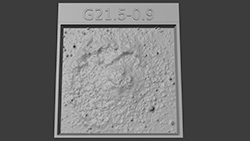
3D Print Credit: NASA/CXC/A. Jubett, using software by Tactile Universe/N. Bonne & C. Krawczyk & Blender
This tactile plate is a physical relief map based on the intensity of X-ray and optical data. In this composite plate, a supermassive black hole at the center of the Centaurus A galaxy shoots an enormous jet of particles into a star-packed sky. Here, Centaurus A resembles layers of streaky clouds. At the heart of the combined cloud structure is the black hole, a protruding dot that lights the clouds from within. The jet emerges from this dot, a speckled beam shooting toward our upper left. Surrounding the entire galaxy is a bubble shape, which is most pronounced at our lower right. This bubble was created by the jets from the black hole. Both the jets and the bubble are detected by Chandra.
Download the Centaurus A Plate STL file
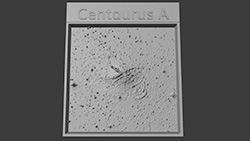
3D Print Credit: NASA/CXC/A. Jubett, using software by Tactile Universe/N. Bonne & C. Krawczyk & Blender
This tactile plate is a physical relief map based on the intensity of X-ray and infrared data. This plate features the Cassiopeia A supernova, an expanding ball of matter and energy ejected from an exploding star. Here, rings of ridges emit veins that push out radially from the center. The rings and their arching veins encircle a place of relative calm at the center of the supernova remnant. This hole at the center of the circle, and the three-dimensionality conveyed by the rings and their arching veins, give this plate of Cassiopeia A the shape of a giant, crackling donut. X-rays detected by Chandra show debris from the destroyed star and the blast wave from the explosion.
Download the Cassiopeia A Plate STL file
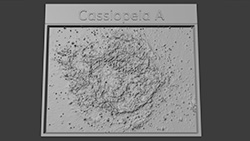
3D Print Credit: NASA/CXC/A. Jubett, using software by Tactile Universe/N. Bonne & C. Krawczyk & Blender
This tactile plate is a physical relief map based on the intensity of X-ray and optical data. This plate of the NGC 3532 star cluster resembles a canvas stippled with thousands of drops of thick paint, flicked from an artist’s brush. From this vantage point, the stars range from minuscule to merely tiny. Some of the stars have pointed cores with faint outlines, running into each other as a mottled overall background, while others protrude and have large outer glows. The stars with faint outlines are those detected in X-rays by Chandra. A faint, haze of cloud streaks across the middle of the plate.
Download the NGC 3532 Plate STL file
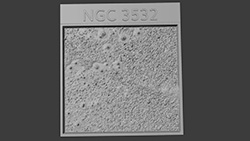
3D Print Credit: NASA/CXC/A. Jubett, using software by Tactile Universe/N. Bonne & C. Krawczyk & Blender
This tactile plate is a physical relief map based on the intensity of X-ray and optical data. In this composite plate, a large spiral galaxy has some of its superheated gas stolen by a smaller, nearby neighbor. Centered in the frame, NGC 6872 is a large spiral galaxy with two elongated arms that stretch toward our upper right and lower left. Near the raised dot at the heart of the galaxy, a cloud surrounds the arms. This cloud represents hot gas detected by Chandra. Just to the upper left of NGC 6872 is a second spiral galaxy. Its spiraling arms are much smaller, but the raised dot at its core is quite large, suggesting a supermassive black hole. Some of the matter and gas from NGC 6872’s lower arm seems to be floating toward the smaller galaxy, likely pulled toward the supermassive black hole.
Download the NGC 6872 Plate STL file
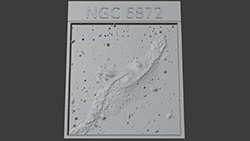
3D Print Credit: NASA/CXC/A. Jubett, using software by Tactile Universe/N. Bonne & C. Krawczyk & Blender
This tactile plate is a physical relief map based on the intensity of X-ray, optical and radio data. This composite plate of the planetary nebula HB5 resembles a bulbous bow tie in mottled texture. At the heart of the nebula, or the knot of the bow tie, is a plateaued circle of explosion. This is a Sun-like star towards the end of its life. To its right and left are matching bulbous spheres of churning gas. Each sphere of gas is several times larger than the exploding knot between them. Also present in the nebula are faint clouds. The cloud most prominent at our upper left represents X-rays observed by Chandra. The other cloud, which surrounds the exploding star, represents radio waves observed by ALMA.
Download the Hb 5 Plate STL file
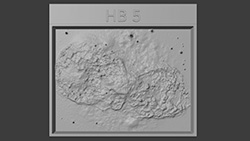
3D Print Credit: NASA/CXC/A. Jubett, using software by Tactile Universe/N. Bonne & C. Krawczyk & Blender
This tactile plate is a physical relief map based on the intensity of X-ray and optical data. In this composite plate of the Abell 2125 galaxy cluster, clouds of superheated gas surround a ball-shaped galaxy. Here, the entire plate is speckled with pointed dots, individual galaxies within the cluster. At the center of the frame is the largest dot, a galaxy surrounded by gas clouds, representing X-rays observed by Chandra. Faint pockets of X-ray gas are found throughout the plate, but the most prominent clouds flank the central galaxy at our upper left and lower right.
Download the Abell 2125 Plate STL file
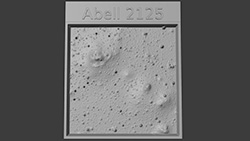
3D Print Credit: NASA/CXC/A. Jubett, using software by Tactile Universe/N. Bonne & C. Krawczyk & Blender
This tactile plate is a physical relief map based on the intensity of X-ray and infrared data. This composite plate features two star clusters, viewed through a churning tunnel of cloud. The cloud creates a border around the entire plate, like a thick swirling smoke ring. Beyond it, in the open center, is a vast field of specks. These specks are young stars observed by Chandra. Within the central field, two cluster groupings are suggested by separate swirls of faint mist. One sits near our upper right. The other is near the bottom left, partially obscured by the ring cloud.
Download the NGC 3324 Plate STL file
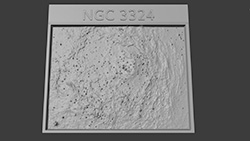
3D Print Credit: NASA/CXC/A. Jubett, using software by Tactile Universe/N. Bonne & C. Krawczyk & Blender
This tactile plate is a physical relief map based on the intensity of X-ray, infrared and optical data. This composite plate features a close-up of the supermassive black hole at the heart of the spiral galaxy known as NGC 1365. The black hole pushes out of the plate at the center, its outer edges raised and mottled. From this core, two thick ropey arms spiral out. Continuing their spiral curves, the arms extend well beyond the edges of the frame. Dotting the plate are a series of pointed, cone-like spots. These are stars paired with smaller black holes or neutron stars, observed by Chandra.
Download the NGC 1365 Plate STL file
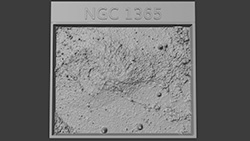
3D Print Credit: NASA/CXC/A. Jubett, using software by Tactile Universe/N. Bonne & C. Krawczyk & Blender
This tactile plate is a physical relief map based on the intensity of X-ray, infrared and optical data. In this composite plate, a pulsar, a pulsar wind nebula, and a low energy X-ray cloud combine to create an uncanny shape of a skeletal hand preparing to grab a glowing ember. The hand reaches up from the bottom of the plate, the ghostly bones representing pulsar wind nebula X-rays observed by Chandra. A raised spot in the wrist is the pulsar itself. Just beyond the hand’s fingertips, near our upper right, is a mottled shape, the low energy X-ray cloud observed by Chandra.
Download the MSH 15-52 Plate STL file
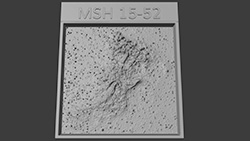
3D Print Credit: NASA/CXC/A. Jubett, using software by Tactile Universe/N. Bonne & C. Krawczyk & Blender
This tactile plate is a physical relief map based on the intensity of X-ray, infrared and optical data. This composite plate features an ultra-luminous infrared galaxy, surrounded by a soft, puffy cloud of X-ray gas. Named Arp 220, this galaxy is the result of a collision between two galaxies, each about the size of our own Milky Way. Here, a single, raised dot sits at the center of the plate. The mottled cloud surrounding the dot appears soft and airy, like cotton candy. Upon close inspection, faint veins can be discerned, marbling the X-ray gas cloud detected by Chandra. Surrounding the gas cloud are other distant galaxies and stars, set against the vastness of space. They range from tiny specks to small, ridged ovals.
Download the Arp 220 Plate STL file
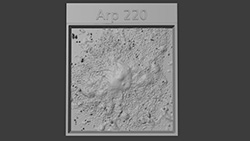
3D Print Credit: NASA/CXC/A. Jubett, using software by Tactile Universe/N. Bonne & C. Krawczyk & Blender
This tactile plate is a physical relief map based on the intensity of X-ray and infrared data, showing Jupiter. The fifth planet from the sun is set against the vastness of space, flanked by puffy blobs. Jupiter is presented in exceptionally clear focus. More than a dozen bands of swirling gas streak the surface, each a different texture. The gas giant is encircled by a fine ring, and a large storm swirls on its surface at our lower right. At the top edge of Jupiter, tilted just to our right of center, is a slightly fuzzy, raised strip. A similar, smaller line can be found at the bottom edge of the planet. Capping the planet’s magnetic poles, these strips represent X-ray auroras, created when high-energy particles collide with gas in the planet’s atmosphere. At our right and left, large blobs flank Jupiter, some larger than the gas giant itself. Like the auroras, these clouds represent X-rays observed by Chandra.
Download the Jupiter Plate STL file
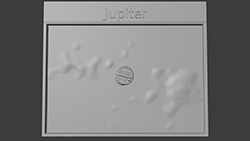
3D Print Credit: NASA/CXC/A. Jubett, using software by Tactile Universe/N. Bonne & C. Krawczyk & Blender
This tactile plate is a physical relief map based on the intensity of X-ray, infrared and optical data. This composite plate features a double star cluster, a cloud, and several dots. This double cluster is part of the Large Magellanic Cloud, a companion galaxy to the Milky Way. The myriad stars in the larger cluster fill the upper center of the plate. The other cluster is much smaller and coincides with one of several circles located slightly above and to the right of the plate’s center. This and the other circles are X-ray sources detected with Chandra. To our left of the combined cluster is a vertical streak of cloud. Extending beyond the upper and lower edges of the plate, this section of cloud resembles wafting smoke from a cigarette.
Download the NGC 1850 Plate STL file
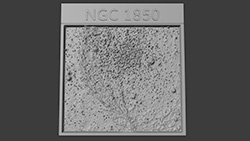
3D Print Credit: NASA/CXC/A. Jubett, using software by Tactile Universe/N. Bonne & C. Krawczyk & Blender
This tactile plate is a physical relief map based on the intensity of X-ray and optical data. This composite plate features dozens of tiny specks, each a distinct galaxy. The cluster, known as MACS J0035, is surrounded by a hazy, softly bulging cloud of hot gas detected by Chandra. From this distance, most of the galaxies in the cluster resemble protruding specks and very short streaks. However, upon close inspection, some of the oblong specks and streaks are revealed to have spiral arms.
Download the MACS J0035 Plate STL file
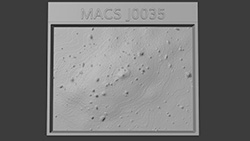
3D Print Credit: NASA/CXC/A. Jubett, using software by Tactile Universe/N. Bonne & C. Krawczyk & Blender
This tactile plate is a physical relief map based on the intensity of X-ray, infrared and optical data. At the center of this composite plate is a small object resembling a Cheerio. This is supernova SN 1987A, named after the year the core-collapse explosion was first observed on Earth. It is located in the Large Magellanic Cloud, a small nearby galaxy. The Cheerio, or equatorial ring, represents material ejected tens of thousands of years before the supernova explosion. The blast wave from the supernova is striking the ring, causing it to produce X-rays detected by Chandra. Inside this ring is a slightly raised dot containing debris from the star that exploded. The ring sits at the center of a ghostly figure 8, outlined in ridges. This entire structure is surrounded by a packed field of stars, specks and dots. A long, mottled cloud hovers near the left edge of the plate.
Download the SN 1987A Plate STL file
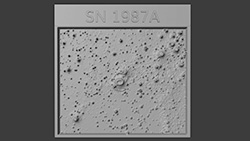
3D Print Credit: NASA/CXC/A. Jubett, using software by Tactile Universe/N. Bonne & C. Krawczyk & Blender
The tactile plate of the Crab Nebula is a physical relief map based on the intensity of X-ray data, taking the shape of a spinning toy top, made of wispy clouds, resting on its side. The top-like shape is outlined by feathery shrouds of energy. In the center, where the point of the toy top shape meets its flared body, is a ball of concentrated light. This is the pulsar, a rapidly rotating neutron star, at the heart of the Crab Nebula. Concentric circles surround the pulsar, as if the pulsar was a small pebble that was dropped into a puddle of water. From the bottom of the neutron star, a jet of matter is rushing downward, like scalding hot steam being released from a valve.
Download the Crab Nebula Plate STL file
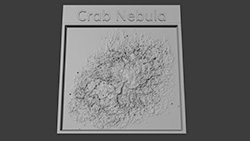
3D Print Credit: NASA/CXC/A. Jubett, using software by Tactile Universe/N. Bonne & C. Krawczyk & Blender
The tactile plate of Cassiopeia A is a physical relief map based on the intensity of X-ray and optical data, depicting this famous supernova remnant. The data show a disk of energy with marbled streaks. X-rays from Chandra reveal puffs of hot gas, mostly from supernova debris from the destroyed star, and include elements like silicon and iron. Brilliant stars shown as points protruding from the surface of the plate, in optical light from Hubble, permeate the field of view.
Download the Cassiopeia A Plate STL file
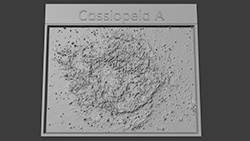
3D Print Credit: NASA/CXC/A. Jubett, using software by Tactile Universe/N. Bonne & C. Krawczyk & Blender
This tactile plate of SN 1181 is a physical relief map based on the intensity of X-ray, optical and infrared data, depicting the remains of a star that exploded hundreds of years ago.
A spherical nebula sits like a puffy dandelion in the middle of the plate, surrounded by a field of stars represented by raised dots. In the center of the nebula is a small point — a neutron star that was left behind after the stellar explosion. From this single point of light, several spectacular rays expand outward like a single firework bursting in celebration in the night sky.
Download the SNR 1181 Plate STL file
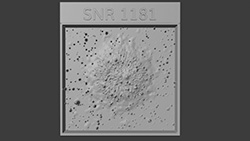
3D Print Credit: NASA/CXC/A. Jubett, using software by Tactile Universe/N. Bonne & C. Krawczyk & Blender
This tactile plate of H1821+643 is a physical relief map based on the intensity of X-ray and radio data, depicting a quasar, a rare and extreme class of supermassive black hole. H1821+643 is located about 3.4 billion light-years from Earth.
At the center of the image is a raised, circular X-ray plateau, similar to a large button ready to be pressed. A less-distinct, bar-shaped structure of radio data, slightly larger than the width of the X-ray plateau, surrounds this circular structure. The radio bar also extends above and below the X-ray button, stretching in a somewhat straight line from about the one o'clock position to the seven o'clock position on a clock face.
On either side of the radio bar, more X-ray data is present as rippling, wispy clouds of hot gas that are raised higher closer to the central features. The more bumpy clouds represent more dense gas.
Download the H1821+643 Plate STL file
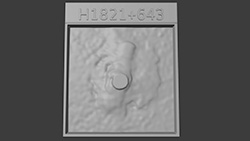
3D Print Credit: NASA/CXC/A. Jubett, using software by Tactile Universe/N. Bonne & C. Krawczyk & Blender
This tactile plate is a physical relief map based on the intensity of X-ray data of a pulsar wind nebula, which strongly resembles a ghostly hand with sparkling fingertips.
A pulsar is a highly magnetized collapsed star that rotates and creates jets of matter flowing away from its poles. These jets, along with intense winds of particles, form pulsar wind nebulae. Here, the pulsar wind nebula known as MSH 15-52 resembles a cloud set against a sparse backdrop.
Both NASA’s Chandra X-ray Observatory and the Imaging X-ray Polarimetry Explorer (IXPE) have observed MSH 15-52. Their observations revealed that the shape of this pulsar wind nebula strongly resembles a human hand, including five fingers, a palm and wrist. The blobby spot near the base of the palm is the pulsar itself.
The three longest fingertips of the hand-shape point toward our upper right, or 1:00 on a clock face. There, a small, mottled cloud appears to sparkle like embers. This cloud is part of the remains of the supernova explosion that created the pulsar.
Download the MSH 15-52 Plate STL file
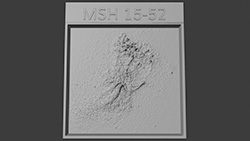
3D Print Credit: NASA/CXC/A. Jubett, using software by Tactile Universe/N. Bonne & C. Krawczyk & Blender
M74 is a spiral galaxy like our own Milky Way. Oriented face-on from our vantage point on Earth, the galaxy’s sparkling arms spiral out from a raised core. The core feels vibrant and dense, crackling with activity. High-energy stars dot the lengths of the spiraling arms. Webs of dust crisscross the space between the curving arms, also known as dust lanes.
Download the M74 Plate STL file
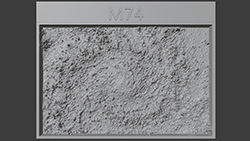
3D Print Credit: NASA/CXC/A. Jubett, using software by Tactile Universe/N. Bonne & C. Krawczyk & Blender
This tactile plate is a physical relief map based on the intensity of X-ray, Radio and Optical data, depicting a supernova remnant called IC 443, or the Jellyfish Nebula. The plate features a large, raised bubble representing X-rays and radio light from hot gas and dust observed by Chandra and other telescopes. Cloud-like structures, both inside the bubble and stretching outside of the bubble to our right and upper left, are filamentary in nature, as if fingers pulled at the edges of a cotton ball. Stars, felt as raised dots, are flecked across the entire image.
Download the IC 443 Plate STL file
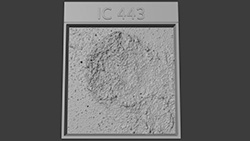
3D Print Credit: NASA/CXC/A. Jubett, using software by Tactile Universe/N. Bonne & C. Krawczyk & Blender
This tactile plate is a physical relief map based on the intensity of X-ray, Radio and Optical data, depicting a string of star clusters resembling beads on a string in the galaxy cluster SDSS J1531. The plate features a central raised cloud representing X-rays from hot gas observed by Chandra, other less prominent clouds representing radio data, and raised dots, curved lines in ridges showing optical data.
The central cloud spreads out for thousands of light-years toward the region above the central galaxies. The less raised area, somewhat resembling the shape of an upside down spinning top toy, stretches far below the two galaxies and slightly toward our left. This cloud represents the remains of a powerful jet, produced by a supermassive black hole within one of the two central galaxies. In the upper right corner of the image, another slightly raised radio cloud is present. This cloud may be the relic of a counter-jet from the same black hole outburst.
Download the SDSS J1531+3414 Plate STL file
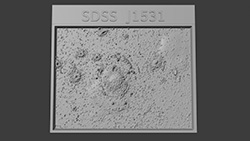
3D Print Credit: NASA/CXC/A. Jubett, using software by Tactile Universe/N. Bonne & C. Krawczyk & Blender
This tactile plate features a physical relief map based on the intensity of X-ray and Optical data, depicting the galaxy cluster named SPT-CLJ0310-4647. The plate features a slightly-raised cloud representing X-rays from hot gas observed by Chandra. The distant galaxies in and around the clouds of hot gas have been captured in optical data, and are raised above the plane of the X-ray cloud.
The vastness of space is packed with specks. These are the individual galaxies. Some of the galaxies resemble fuzzy-edged dots. In other galaxies, the curving arms of a spiral formation are discernible. At the center of the image, the more indistinct X-ray cloud surrounds several of the cluster’s most prominent galaxies.
Download the SPT-CLJ0310-4647 Plate STL file
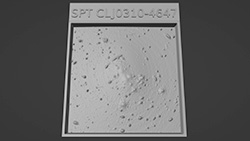
3D Print Credit: NASA/CXC/A. Jubett, using software by Tactile Universe/N. Bonne & C. Krawczyk & Blender
This tactile plate features a physical relief map of Cassiopeia A based on the intensity of X-ray light from Chandra, Infrared light from Webb and Spitzer, and Optical light from Hubble. The resulting tactile plate of Cassiopeia A resembles a disk of electric light with clouds and streaks. An area near the center of the remnant resembles a somewhat circular region of lightning. X-rays from Chandra reveal hot gas, mostly from supernova debris from the destroyed star, and include elements like silicon and iron. X-rays are also present as thin arcs in the outer regions of the remnant.
Data from Webb highlights infrared emission from dust that is warmed up because it is embedded in the hot gas detected by Chandra, and from much cooler supernova debris. Hubble data shows a multitude of stars that dot the field of view.
Download the Cassiopeia A Plate STL file

3D Print Credit: NASA/CXC/A. Jubett, using software by Tactile Universe/N. Bonne & C. Krawczyk & Blender
This tactile plate features a physical relief map based on the intensity of X-ray, optical & infrared data, depicting a large region of space where stars have been continuously forming for the past eight to ten million years. At the center of this complex landscape of gas clouds is a supernova remnant known as 30 Doradus B. The remnant likely contains the remains of at least two exploded stars.
The entire image is awash in intricate clouds, and swathes of superheated gas. At our upper lefthand corner is a thick cloud with a texture like cotton candy. At our lower and upper right is a network of clouds that resemble streaks of thick syrup floating in water. A layer of wispy cloud appears to drape across the entire image, but is most evident at our lower left which is free of overlapping gas. Specks of light, which are stars, dot the plate.
In the center of the frame is a raised cloud, flecked with dots, and streaked with lightning-like veins. This is 30 Doradus B, which is delineated by a faint shell of X-rays identified by Chandra. Within this supernova remnant are high energy shocks and winds of particles blowing away from a pulsar.
Download the 30 Doradus Plate STL file
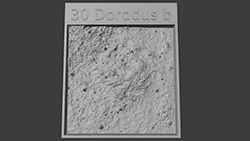
3D Print Credit: NASA/CXC/A. Jubett, using software by Tactile Universe/N. Bonne & C. Krawczyk & Blender
The tactile plate of NGC 2246 features a physical relief map based on the intensity of X-ray, Optical & Infrared data, depicting a cluster of young stars shaped decidedly like a cosmic Christmas tree! The cluster, known as NGC 2264, is in our Milky Way Galaxy, about 2,500 light-years from Earth. Some of the stars in the cluster are relatively small, and some are relatively large, ranging from one tenth to seven times the mass of our Sun.
In this tactile plate, the cluster’s resemblance to a Christmas tree has been enhanced through feature rotation. Optical data is represented by wispy lines and shapes, which creates the boughs and needles of the tree. X-rays detected by Chandra are presented as dots of light on the tree. Infrared data show foreground and background stars as raised specks against the emptiness of space. The plate has been rotated by about 150 degrees from the astronomer’s standard of North pointing upwards. This puts the peak of the roughly conical tree shape near the top of the plate, though it doesn’t address the slight bare patch in the tree’s branches, at our lower right, which should probably be turned to the corner.
Download the NGC 2264 Plate STL file
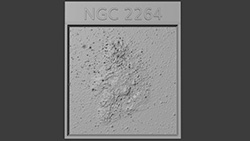
3D Print Credit: NASA/CXC/A. Jubett, using software by Tactile Universe/N. Bonne & C. Krawczyk & Blender
This tactile plate of a globular cluster features a physical relief map based on the intensity of X-ray, Infrared & Optical data. A globular cluster is a sphere-shaped collection of stars bound together by gravity.
Scores of tiny stars dot the space, many jutting out of the plate. Like other globular clusters, this conglomeration, named Omega Centauri, is more densely packed near the center.
In Omega Centauri are eleven spider pulsars toward the inner half of the sphere, which obliterate their companion stars with strong winds of particles. Each spider pulsar is the spinning core of a collapsed massive star. As they spin, the spider pulsars emit beams of radiation, like light from a lighthouse. The pulsars also produce winds of particles that methodically strip away their companion stars, layer by layer.
Download the Omega Centauri Plate STL file
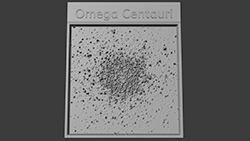
3D Print Credit: NASA/CXC/A. Jubett, using software by Tactile Universe/N. Bonne & C. Krawczyk & Blender
The tactile plate of UHZ1 behind Abell 2744 features a physical relief map based on the intensity of X-ray and infrared data, depicting a black hole in an early stage of its development, just 470 million years after the Big Bang.
The plate shows data from NASA’s Chandra X-ray Observatory and James Webb Space Telescope. It features scores of seemingly tiny celestial objects. This is the galaxy cluster Abell 2744. These tiny celestial objects are spiral and elliptical galaxies, and gleaming stars. Many of these specks appear to float in a raised, bumpy cloud of X-ray gas in the center of the image, some 3.5 billion light-years from Earth.
Just to the right of center, at the edge of the raised gas cloud, is a tiny speck. This speck is far in the distance, well beyond the Abell galaxy cluster, and difficult to discern from the rest of the data, so we have added a raised box to show its location. It represents a galaxy 13.2 billion light-years from Earth containing a supermassive black hole.
Download the UHZ1 Plate STL file
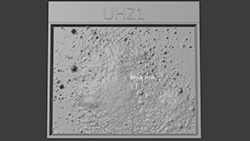
3D Print Credit: NASA/CXC/A. Jubett, using software by Tactile Universe/N. Bonne & C. Krawczyk & Blender
This tactile plate is a physical relief map based on the intensity of X-ray data of a pulsar wind nebula, which strongly resembles a ghostly hand with sparkling fingertips.
A pulsar is a highly magnetized collapsed star that rotates and creates jets of matter flowing away from its poles. These jets, along with intense winds of particles, form pulsar wind nebulae. Here, the pulsar wind nebula known as MSH 15-52 resembles a cloud set against a sparse backdrop.
Both NASA’s Chandra X-ray Observatory and the Imaging X-ray Polarimetry Explorer (IXPE) have observed MSH 15-52. Their observations revealed that the shape of this pulsar wind nebula strongly resembles a human hand, including five fingers, a palm and wrist. The blobby spot near the base of the palm is the pulsar itself.
The three longest fingertips of the hand-shape point toward our upper right, or 1:00 on a clock face. There, a small, mottled cloud appears to sparkle like embers. This cloud is part of the remains of the supernova explosion that created the pulsar.
Download the MSH 15-52 Plate STL file

3D Print Credit: NASA/CXC/A. Jubett, using software by Tactile Universe/N. Bonne & C. Krawczyk & Blender
This tactile plate is a physical relief map based on the intensity of X-ray data of the supernova remnant SN 1006, showing debris from an exploded star that resembles a mottled ball of churning fire. The turbulent supernova remnant appears to be encircled by a thin ring that is most prominent at our lower right and upper left.
At the upper lefthand corner of the plate, the outer ring of the supernova remnant stands out. This ring is part of the supernova’s expanding blast wave, which has been observed in X-ray light by the Chandra X-ray Observatory.
Download the SN 1006 Plate STL file
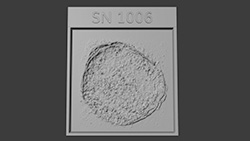
3D Print Credit: NASA/CXC/A. Jubett, using software by Tactile Universe/N. Bonne & C. Krawczyk & Blender
This tactile plate features a relief map of a Chandra X-ray image of Eta Carinae, a cosmic explosion that sky watchers have been observing since the middle of the 19th century. About 180 years ago, a huge explosion inside the Eta Carinae star system ejected massive amounts of material in an event dubbed the “Great Eruption”. The resulting gas and debris cloud has been expanding ever since.
In the plate, a distinct ball is encircled by a patchy ring of material. The ball represents X-rays from two massive stars, 30 and 90 times the mass of our sun. These stars are too close together to be felt individually. The oblong gas ring encircling them is tilted, stretching toward our upper right and lower left.
Download the Eta Carinae Plate STL file
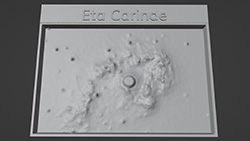
3D Print Credit: NASA/CXC/A. Jubett, using software by Tactile Universe/N. Bonne & C. Krawczyk & Blender
A close-up of the spiral galaxy NGC 1365, and the supermassive black hole at its center. The galaxy is shown at a dramatic angle, as if the raised plateau of a core is gazing past our right shoulder. Swirls of material, resembling waves in a dark ocean, spiral toward the core, which hangs at our upper left. Spiraling circles, and flecks dot the churning spiral galaxy. In this plate, Chandra X-ray data has been combined with infrared data from NASA’s James Webb Space Telescope.
Download the NGC 1365 Plate STL file
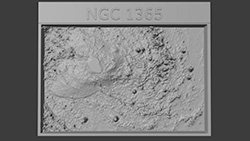
3D Print Credit: NASA/CXC/A. Jubett, using software by Tactile Universe/N. Bonne & C. Krawczyk & Blender
A bump of light encircled by subtle swirls rockets toward our upper left, leaving two, long, streaming tails behind it. This is ESO 137-001, a galaxy moving through space at 1.5 million miles per hour. Set against a background packed with pointy stars, the galaxy's twin tails feature streams of raised material floating inside superheated gas. Clusters of dots, hydrogen atoms, seem to travel with the galaxy, alongside the flowing tails. The object depicts X-ray light collected from Chandra, light from hydrogen atoms from ESO’s Very Large Telescope, and optical and infrared light from Hubble.
Download the ESO 137-001 Plate STL file
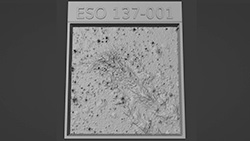
3D Print Credit: NASA/CXC/A. Jubett, using software by Tactile Universe/N. Bonne & C. Krawczyk & Blender
The remains of a white dwarf star that was destroyed by a thermonuclear explosion. The image plate represents X-ray light from Chandra, optical light from the Hubble Space Telescope and infrared light from the Spitzer Space Telescope. The remnant resembles a knotted ball of crackling energy, set against a sparse sky dotted with specks. Streaks and patches of mottled texture represent debris from the destroyed star. A web of veins encircles and weaves through the knot, representing the powerful blast wave captured by Chandra.
Download the Kepler's Supernova Remnant Plate STL file
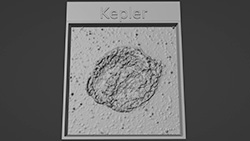
3D Print Credit: NASA/CXC/A. Jubett, using software by Tactile Universe/N. Bonne & C. Krawczyk & Blender
The busy and active center of our Milky Way galaxy resembles a cloud, dotted with several orbs of light. Surrounding the cloud is a dense field of specks that entirely blankets the sky. In this plate, all raised areas represent X-ray light from Chandra.
Download the Galactic Center Plate STL file
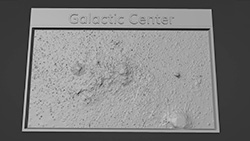
3D Print Credit: NASA/CXC/A. Jubett, using software by Tactile Universe/N. Bonne & C. Krawczyk & Blender
The aftermath of a collapsed and exploded star sending a jet of particles into space. The pulsar resembles a soft, pillowy, bean in a pocket of gas. A faint stream of gas, the X-ray jet, seems to shoot from the pocket, heading into the distance at our upper right. Raised markings in the bean shape suggest narrow eyes and an open mouth, giving the pulsar a squinting happy face. The tactile plate combines data from NASA’s Imaging X-ray Polarimetry Explorer, Chandra, and Hubble.
Download the Vela Pulsar Plate STL file
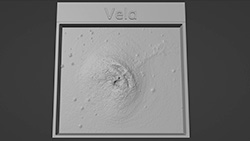
3D Print Credit: NASA/CXC/A. Jubett, using software by Tactile Universe/N. Bonne & C. Krawczyk & Blender
This tactile plate features a distant galaxy cluster known as SPT2215. The galaxy cluster resembles a raised cloud with a raised peak at its core. The cluster is set against the emptiness of space, which is dotted with raised pinpoints of light. A combination of X-ray, ultraviolet, optical, and infrared information was used to create the plate.
Download the SPT-CL J2215-3537 Plate STL file
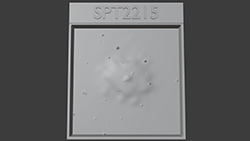
3D Print Credit: NASA/CXC/A. Jubett, using software by Tactile Universe/N. Bonne & C. Krawczyk & Blender
The primary image features a top panel and a bottom panel. The top panel offers an image of the Milky Way's core, courtesy of Chandra's X-ray Observatory. In this rendering, the Milky Way resembles layers of neon pink and dark blue clouds, dotted with specks of light in similar colors. Two bright spots in light blue glow to our left of center.
Download the Sagittarius A* / Galactic Center Plate STL file
Download the Sagittarius A* / Galactic Center Plate GLB file
Download the Sagittarius A* / Galactic Center Plate OBJ file
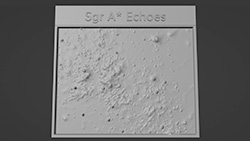
3D Print Credit: NASA/CXC/A. Jubett, using software by Tactile Universe/N. Bonne & C. Krawczyk & Blender
In the system R Aquarii, a white dwarf star and a red giant star are in orbit around one another. In the composite tactile plate, the two stars are represented by a raised area at the center of the image. The stars sit at the center of a giant, wispy cross that extends to all four edges of the plate. This structure is evidence of outbursts generated by the pair of stars. A wavy line creates a ridge of shapes along the horizontal bar of the cross. These shapes represent an X-ray jet from the white dwarf star. The jet creates shockwaves as it bangs into surrounding material.
Download the R Aquarii Plate STL file
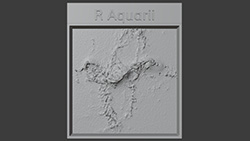
3D Print Credit: NASA/CXC/A. Jubett, using software by Tactile Universe/N. Bonne & C. Krawczyk & Blender
Stephan’s Quintet is a gathering of four galaxies held together by gravity. The fifth galaxy appears to be part of the group from our perspective, but is in fact much closer to us. The composite tactile plate combines optical, X-ray, and infrared data. In it, the galaxies are clumped together, resembling the wings of a butterfly. The distinct clouds are marbled with bumpy veins, and connected by streaks of material.
Download the Stephan's Quintet Plate STL file
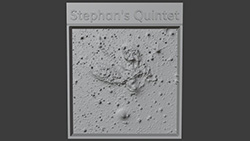
3D Print Credit: NASA/CXC/A. Jubett, using software by Tactile Universe/N. Bonne & C. Krawczyk & Blender
Messier 104 is a spiral galaxy, but from Earth, we observe its edge, not its face. In the composite tactile plate, Messier 104 resembles a cloud with a raised core, encircled by a horizontal ring of spiraling arms. In the background are dozens of dots, which represent distant stars and galaxies.
Download the M104 Plate STL file
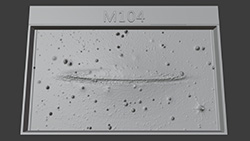
3D Print Credit: NASA/CXC/A. Jubett, using software by Tactile Universe/N. Bonne & C. Krawczyk & Blender
This release features three tactile plates of a galaxy group plunging into a galaxy cluster, one of the largest structures in the universe. The first two plates, both labeled “Coma Cluster,” show the NGC 4839 galaxy group approaching the heart of the Coma Galaxy cluster. The third plate, labeled “NGC 4839,” is a closeup of the galaxy group and its extraordinary tail.
The wide field of view in the first two plates depicts the Coma galaxy cluster as a large gas cloud with a hazy core. Sitting to our left of center, this cloud-within-a-cloud is dotted with hundreds of pointy specks. Each speck is a distinct galaxy. At the lower right of this plate, a smaller cloud approaches. This is the galaxy group NGC 4839 and its comet-like tail. This cloud is vaguely shaped like a slice of pie, with a protruding dot at the tip. This tip points toward the core as it enters the outer edge of the cluster’s gas cloud. The cluster, the group, and the cloud around them are set against a more sparse, starry sky. In these two plates, they are presented using data from the XMM-Newton observatory, and the Sloan Digital Sky Survey. In one plate, an arrow labeled “NGC 4839” points directly to the tip of NGC 4839.
The third plate is a close up of the approaching galaxy group, which is much less pie-shaped from this perspective. This plate using Chandra data has been rotated such that the cluster is traveling horizontally toward our left, not our upper left as in the previous two plates. At the tip of the galaxy group is a large protruding dot. This is the ‘Head’ of the galaxy group. Here, the cloud trailing behind the head is raised and flecked with pointy specks. This is a tail of hot gas stripped off the galaxy group’s head as it plunges into the cloud of gas surrounding the Coma cluster. This comet-like tail is 1.5 million light-years long, and is filled with key ingredients to make future generations of stars and planets.
Download the NGC 4839 Plate STL file
Download the NGC 4839 Plate GLB file
Download the NGC 4839 Plate OBJ file
Download the Coma Cluster/NGC 4839 (Labeled) Plate STL file
Download the Coma Cluster/NGC 4839 (Labeled) Plate GLB file
Download the Coma Cluster/NGC 4839 (Labeled) Plate OBJ file
Download the Coma Cluster/NGC 4839 (Unlabeled) Plate STL file
Download the Coma Cluster/NGC 4839 (Unlabeled) Plate GLB file
Download the Coma Cluster/NGC 4839 (Unlabeled) Plate OBJ file
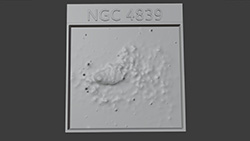
3D Print Credit: NASA/CXC/A. Jubett, using software by Tactile Universe/N. Bonne & C. Krawczyk & Blender
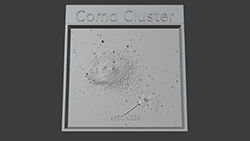
3D Print Credit: NASA/CXC/A. Jubett, using software by Tactile Universe/N. Bonne & C. Krawczyk & Blender
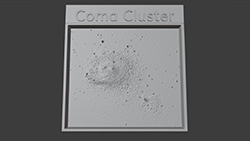
3D Print Credit: NASA/CXC/A. Jubett, using software by Tactile Universe/N. Bonne & C. Krawczyk & Blender
The Eagle Nebula is often referred to as the “Pillars of Creation”. In this image, tall columns of gas and dust emerge from the bottom edge of the plate, stretching toward our upper right. Backed by mist, the cloudy columns are surrounded by dozens of dots; massive stars emitting enormous amounts of X-rays. The shapes in this composite create a dream-like plane. Churning with turbulent gas and dust, the columns lean to our right with small offshoots pointing in the same direction. These details evoke a scene of yearning cloud creatures at dusk, pointing at something just out of frame.
Download the M16 Plate STL file
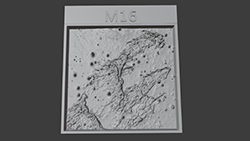
3D Print Credit: NASA/CXC/A. Jubett, using software by Tactile Universe/N. Bonne & C. Krawczyk & Blender
M74 is a spiral galaxy like our own Milky Way. Oriented face-on from our vantage point on Earth, the galaxy’s sparkling arms spiral out from a raised core. The core feels vibrant and dense, crackling with activity. High-energy stars dot the lengths of the spiraling arms. Webs of dust crisscross the space between the curving arms, also known as dust lanes.
Download the M74 Plate STL file
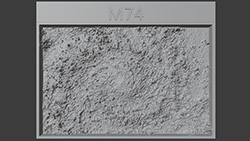
3D Print Credit: NASA/CXC/A. Jubett, using software by Tactile Universe/N. Bonne & C. Krawczyk & Blender
Spiral galaxy NGC 1672 is shown face on. This spiral galaxy has two major arms curving away from the swirling light at its core. One arm extends to our lower left with a gentle upward curve. The other extends to our upper right with a curve reminiscent of a question mark. Both arms have a cloudy quality, and are dotted with stars of varying sizes. In this galaxy, categorized as a “barred” spiral, the arms don’t seem to reach the raised core. The space around the core is a swirl of murky cloud.
Download the NGC 1672 Plate STL file
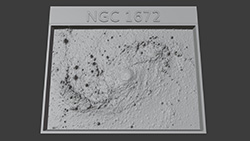
3D Print Credit: NASA/CXC/A. Jubett, using software by Tactile Universe/N. Bonne & C. Krawczyk & Blender
In the NGC 346 star cluster, thousands of specks of light blanket the image. A ribbon of thick cloud runs along the bottom edge of the image, rounds our lower right corner, and streaks up the right side. A similar patch of roiling cloud can be found near our upper left. Between these gas plumes, centered near the top of the image, the star cluster is densely packed with specks of light. At our left, a large dot is surrounded by speckled mist. This is a hot, young, massive star, sending powerful winds outward from its surface. A patch of smaller dots, other young stars, can be found near the center of the image.
Download the NGC 346 Plate STL file
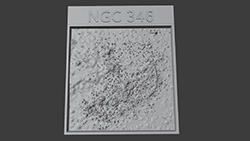
3D Print Credit: NASA/CXC/A. Jubett, using software by Tactile Universe/N. Bonne & C. Krawczyk & Blender
This tactile plate shows the galaxy Messier 84 (M84). The file for this plate can be downloaded and 3D-printed for learners to touch.
Download the M84 Plate STL file
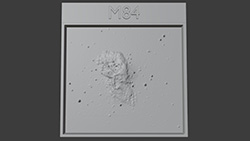
3D Print Credit: NASA/CXC/A. Jubett, using software by Tactile Universe/N. Bonne & C. Krawczyk & Blender
This tactile plate depicts the central area of the spiral galaxy NGC 253 as a physical relief map based on the intensity of X-ray data captured by Chandra. The file for this plate can be downloaded and 3D-printed for learners to touch.
At the center of the spiral galaxy is a large blob. That is the galactic wind of extremely hot gas, detected by the Chandra X-ray Observatory.
Download the NGC 253 Composite Plate STL file
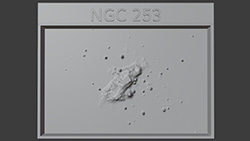
3D Print Credit: NASA/CXC/A. Jubett, using software by Tactile Universe/N. Bonne & C. Krawczyk & Blender
This tactile plate depicts the central area of the spiral galaxy NGC 253 as a physical relief map based on the intensity of X-ray data captured by Chandra and infrared and optical data from other telescopes. The file for this plate can be downloaded and 3D-printed for learners to touch.
At the center of the spiral galaxy is a large blob. That is the galactic wind of extremely hot gas, detected by the Chandra X-ray Observatory. Surrounding the blob are mottled clouds and swirling structures from the infrared and optical light captured. In the image, hot winds are blowing in opposite directions away from the center of the galaxy. These powerful winds are spreading stellar material to the galaxy's next generation of stars and planets.
Download the NGC 253 Composite Plate STL file
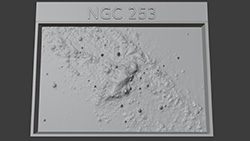
3D Print Credit: NASA/CXC/A. Jubett, using software by Tactile Universe/N. Bonne & C. Krawczyk & Blender
This tactile plates is a composite image of galaxy collisions as a physical relief map based on the intensity of X-ray data captured by Chandra and optical data from other telescopes.
This plate features two colliding dwarf galaxies in the early stages of merging. In this pair of dwarf galaxies, a cloud with a raised circle at its core sits above a larger companion with a similar shape. These clouds are the dwarf galaxies known as Vinteuil and Elstir. The raised cores represent black holes tracked by Chandra. Elstir, the larger object, near the bottom, features wispy tendrils. Several of these tendrils appear to reach up toward the smaller galaxy, Vinteuil, creating a bridge of gas and stars.
Download the Elstir and Vinteuil Plate STL file
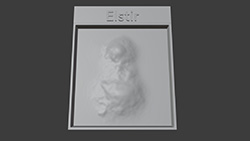
3D Print Credit: NASA/CXC/A. Jubett, using software by Tactile Universe/N. Bonne & C. Krawczyk & Blender
This tactile plates is a composite image of galaxy collisions as a physical relief map based on the intensity of X-ray data captured by Chandra and optical data from other telescopes.
The plate features two colliding dwarf galaxies in the late stages of merging into one larger galaxy. In this plate, a cloud represents gas and stars in the merging galaxies. The shape at its core represents a black hole being tracked by the Chandra X-ray Observatory. Directly above the cloud is another black hole, followed by a tail, curving up and to our right, caused by tidal effects from the ongoing collision. Because these two dwarf galaxies are in the final stages of merging, scientists have given the combined galaxy a single name: Mirabilis.
Download the Mirabilis Plate STL file
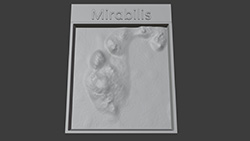
3D Print Credit: NASA/CXC/A. Jubett, using software by Tactile Universe/N. Bonne & C. Krawczyk & Blender
Abell 2256 is a collision of galaxy clusters about 780 million light-years away. This tactile plate depicts Abell 2256 as a physical relief map based on the intensity of X-ray data captured by Chandra as well as radio, optical and infrared data. The file for this plate can be downloaded and 3D-printed for learners to touch.
This plate features a composite image of at least three galaxy clusters colliding in a jumbled scene. The resulting giant galaxy cluster, Abell 2256, resembles a grainy, pixelated cloud topped with licks of flaming hair. The “hair,” or relics, are the results of shockwaves, likely generated by the collision of gas from the different clusters. Near the lower left sits the oval-shaped cloud, the center of the combined galaxy cluster. Shooting out of the giant cluster, angled toward our upper-middle right, is a straight, thin line. This is a jet; a stream of particles blasting away from a giant black hole. A second, much shorter jet crosses the tip of the first jet near the right-hand side of the image.
In the giant cluster, on the right hand side, are several irregular shapes. These are filaments, the result of jets interacting with gas. Three other irregular filaments can be found to our left, just outside of the giant cluster.
Download the Abell 2256 Plate STL file
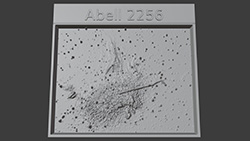
3D Print Credit: NASA/CXC/A. Jubett, using software by Tactile Universe/N. Bonne & C. Krawczyk & Blender
30 Doradus, otherwise known as the Tarantula Nebula, is a region of active star formation in a neighboring galaxy. This tactile plate depicts 30 Doradus as a physical relief map based on the intensity of X-ray data captured by the Chandra X-ray Observatory and infrared data from the James Webb Space Telescope. The file for this plate can be downloaded and 3D-printed for learners to touch.
In the plate, small specks of light and larger points of stars interact with gas clouds. The brightest and most prominent cloud of X-ray gas appears at the center of the image, roughly shaped like an upward pointing triangle. Darker X-ray clouds can be found near the right and left edges of the image. Thinner patches resembling clouds of roiling fire are the infrared light. The brightest and most prominent infrared cloud appears at the upper left, roughly shaped like a downward pointing triangle. Wispy patches outline the upward pointing bright triangle in the center of the image. Inside this frame is a very bright star with six long, thin, diffraction spikes. Beside it is a cluster of smaller bright specks showing young stars in the nebula.
Download the 30 Doradus Plate STL file

3D Print Credit: NASA/CXC/A. Jubett, using software by Tactile Universe/N. Bonne & C. Krawczyk & Blender
NGC 3293 is a star cluster about 8,300 light years from Earth. This tactile plate depicts NGC 3293 as a physical relief map based on the intensity of X-ray data captured by Chandra and infrared data from Spitzer and Herschel. The file for this plate can be downloaded and 3D-printed for learners to touch.
This image of NGC 3293 resembles a cone of bright stars and wispy clouds, set against a starry sky. The narrow point of the roughly cone-shaped cloud rests in the center of the image with the wide mouth at our upper right. The narrow end of the cone shape features dozens of large, bright, gleaming stars as sharp points. The background of the plate is packed with more stars that make up the cluster.
Download the NGC 3293 Plate STL file
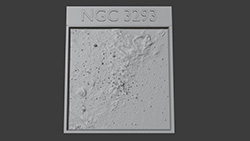
3D Print Credit: NASA/CXC/A. Jubett, using software by Tactile Universe/N. Bonne & C. Krawczyk & Blender
RCW 36 is a region of star formation about 2,900 light-years from Earth. This tactile plate depicts RCW 36 as a physical relief map based on the intensity of X-ray data captured by Chandra and infrared data from Herschel. The file for this plate can be downloaded and 3D-printed for learners to touch.
The plate depicts a large hot gas cloud flecked with dots, where the dots are new stars, a major source of the region’s hot gas. At our lower left and upper right are two large cavities, or voids, carved out of the gas. In the center of the image is a ring of gas wrapping around the central star cluster.
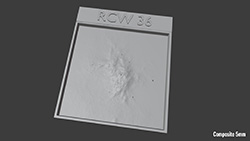
3D Print Credit: NASA/CXC/A. Jubett, using software by Tactile Universe/N. Bonne & C. Krawczyk & Blender
V404 Cygni is a binary system where a stellar-mass black hole is in orbit with a “normal” star. This tactile plate depicts V404 Cygni as a physical relief map based on the intensity of X-ray data captured by Chandra. The file for this plate can be downloaded and 3D-printed for learners to touch.
At the very center of the V404 system is a black hole (which cannot be felt as it is not visible in the image) surrounded by material that has produced bursts of radiation, or light. These bursts expand outward in concentric rings which reflect off gas and dust clouds. The rings of radiation are grainy and blurred in texture, like curved tire marks left in wet snow. The smallest ring, closest to the center, is tightest and brightest. The largest ring, furthest from the core, is most faint and appears to have dissipated.
Download the V404 Plate STL file
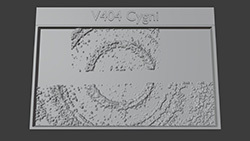
3D Print Credit: NASA/CXC/A. Jubett, using software by Tactile Universe/N. Bonne & C. Krawczyk & Blender
This tactile plate depicts a system of galaxy clusters known as Abell 98, as a physical relief map based on the intensity of X-ray data captured by Chandra and optical data from the WIYN telescope. The file for this plate can be downloaded and 3D-printed for learners to touch.
The plate of Abell 98, about 1.4 billion light years from Earth, depicts little specks — mostly galaxies. Near the top and bottom of the plate are clouds of gas, each with a cluster of galaxies at its core. The two galaxy clusters are in the early stages of a collision. Upon close inspection, a faint corridor of gas can be found bridging the space between the clusters. Scientists have proposed that this X-ray bridge between the clusters contains some of the unaccounted-for mass in the universe. Hidden in this bridge are gigantic strands, or filaments, of hot gas.
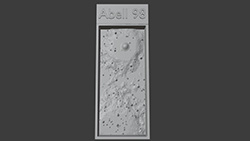
3D Print Credit: NASA/CXC/A. Jubett, using software by Tactile Universe/N. Bonne & C. Krawczyk & Blender
This tactile plate depicts the Carina Nebula as a physical relief map based on the intensity of X-ray data captured by Chandra and infrared data captured by the Webb Space Telescope. The file for this plate can be downloaded and 3D-printed for learners to touch.
GThe Carina Nebula resembles a mountain range backed by a hazy night sky. A curtain of dust and gas in the nebula occupies the bottom half of the plate. The sky-like area above is streaked with vertical bands of haze which rise from the nebula below. Faint cloudy areas show hot gas that was blown away from massive stars. A starfield of specks blankets the entire plate. Three thin long diffraction spikes entering the image at our upper right hint at the presence of a bright star just out of view.
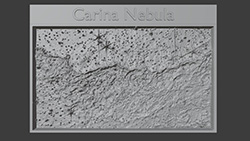
3D Print Credit: NASA/CXC/A. Jubett, using software by Tactile Universe/N. Bonne & C. Krawczyk & Blender
This tactile plate depicts the galaxy cluster SMACS 0723 as a physical relief map based on the intensity of X-ray data captured by Chandra and infrared data captured by the Webb Space Telescope. The file for this plate can be downloaded and 3D-printed for learners to touch.
Galaxy cluster SMACS 0723 contains hundreds of individual galaxies in a sea of black space. Here the galaxies resemble specks of light. Some feel with diffraction spikes radiating from the center. Some feel like tiny swirling pinwheels. Some of the galaxies located far behind the cluster resemble short arcing streaks, their light having been bent by the mass of galaxies in the cluster. Near the center of the image, where some of the brightest galaxies reside, is a faint, haze. This is superheated gas with a total mass of about 100 trillion times that of the sun, revealed by the Chandra observatory.
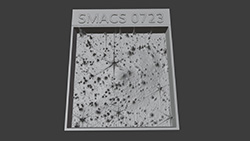
3D Print Credit: NASA/CXC/A. Jubett, using software by Tactile Universe/N. Bonne & C. Krawczyk & Blender
This tactile plate depicts the Cartwheel galaxy as a physical relief map based on the intensity of X-ray data captured by Chandra and infrared data captured by the Webb Space Telescope. The file for this plate can be downloaded and 3D-printed for learners to touch.
The Cartwheel galaxy presents as a disk with an outer ring, and a solid, slightly off-center spiraling core. Linking the smooth core and the irregular outer ring are wispy plumes of silicate dust which resemble twisted spokes on a bicycle wheel. At the upper left of the plate are two companion galaxies which appear to be about the same size as the core of the Cartwheel galaxy. One companion galaxy is shaped like a backwards S, and is marked by bright dots and tangles of fine crinkly lines. Below it, the second companion galaxy appears delicate and smooth, like a faded swirl of cotton candy.
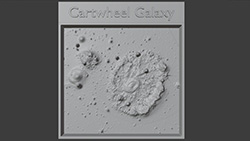
3D Print Credit: NASA/CXC/A. Jubett, using software by Tactile Universe/N. Bonne & C. Krawczyk & Blender
This tactile plate depicts a group of galaxies, Stephan’s Quintet, as a physical relief map based on the intensity of X-ray data captured by Chandra and infrared data captured by the Webb and Spitzer Space Telescopes. The file for this plate can be downloaded and 3D-printed for learners to touch.
The plate of Stephan’s Quintet shows five galaxies. Two of the galaxies appear close together at the center of the plate. One appears directly above, and another slightly to our left near the bottom of the image. Each of these four galaxies presents as an irregular dot of brilliant light surrounded by a glowing haze. A fifth galaxy peaks out from the center left in an oval shape marbled with a tangle of lines. Similar tangles appear around the two galaxies at the center of the image, and the galaxy above them. Above the two galaxies at the center is a squiggly cloud. This is a shock wave uncovered by the Chandra data. Scattered across the image are many specks — gleaming stars and distant galaxies.
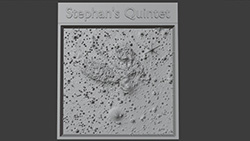
3D Print Credit: NASA/CXC/A. Jubett, using software by Tactile Universe/N. Bonne & C. Krawczyk & Blender
This tactile plate depicts a star, Zeta Ophiuchi as a physical relief map based on the intensity of the X-ray data captured by Chandra and the infrared data captured by Spitzer. The file for this plate can be downloaded and 3D-printed for learners to touch.
The star Zeta Ophiuchi, which is about 20 times more massive than our Sun, is the main source located at the center of the image. The shockwave appears to the left of the star, with a curve like an archer's bow. Astronomers believe that this shockwave was formed by matter blowing away from Zeta Ophiuchi's surface and slamming into gas in its path, as the star moves from right to left. There are thinner, fainter clouds that streak the entire plate. These faint clouds, felt as thin ridges, represent the gas in the path of the star's shockwave. In the background, small specks, or stars, dot the blankness of space.
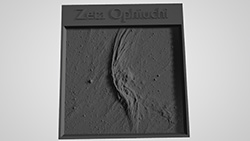
3D Print Credit: NASA/CXC/A. Jubett, using software by Tactile Universe/N. Bonne & C. Krawczyk & Blender
This tactile plate depicts SNR 0519-69.0, the remnant of a supernova, as a physical relief map based on the intensity of the X-ray data captured by Chandra. The file for this plate can be downloaded and 3D-printed for learners to touch.
On the plate, a mottled blob floats in a dark sky. The blob is the remnant of the supernova, the debris from an exploded white dwarf star. This star exploded several hundred years ago, within Earth's timeframe. Across the surface of the supernova remnant, bulges in the shape are like the lines between the rounded plates on a turtle's shell.
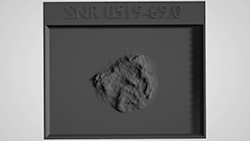
3D Print Credit: NASA/CXC/A. Jubett, using software by Tactile Universe/N. Bonne & C. Krawczyk & Blender
This tactile plate depicts supernova remnant G292, as a physical relief map based on the intensity of the X-ray data captured by Chandra. The file for this plate can be downloaded and 3D-printed for learners to touch.
The G292.0+1.8 supernova remnant contains a pulsar moving at over a million miles per hour, as marked in the Chandra image. Pulsars are rapidly spinning neutron stars that can form when massive stars run out of fuel, collapse, and explode. Sometimes these explosions produce a “kick,” which sent this pulsar.
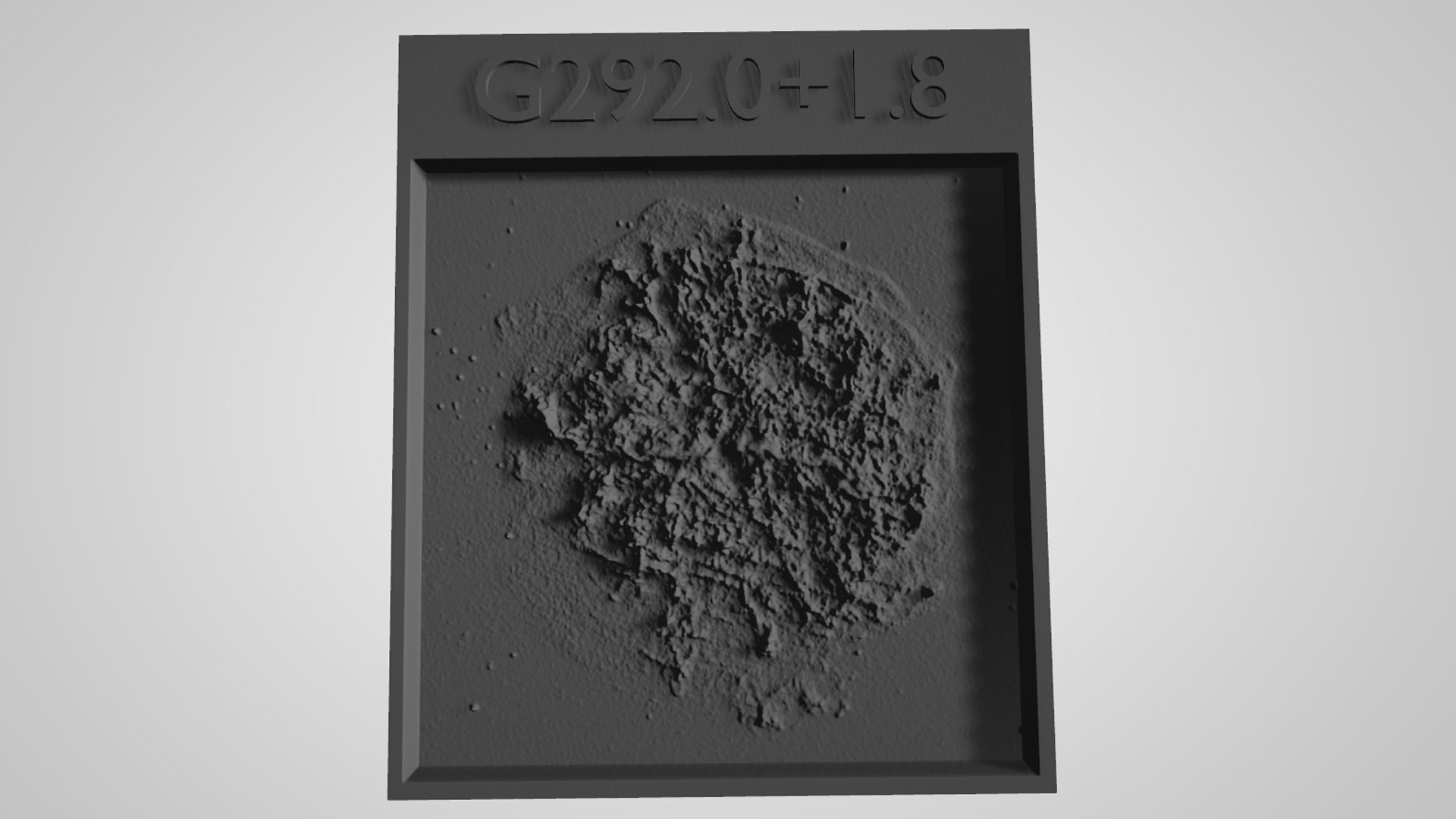
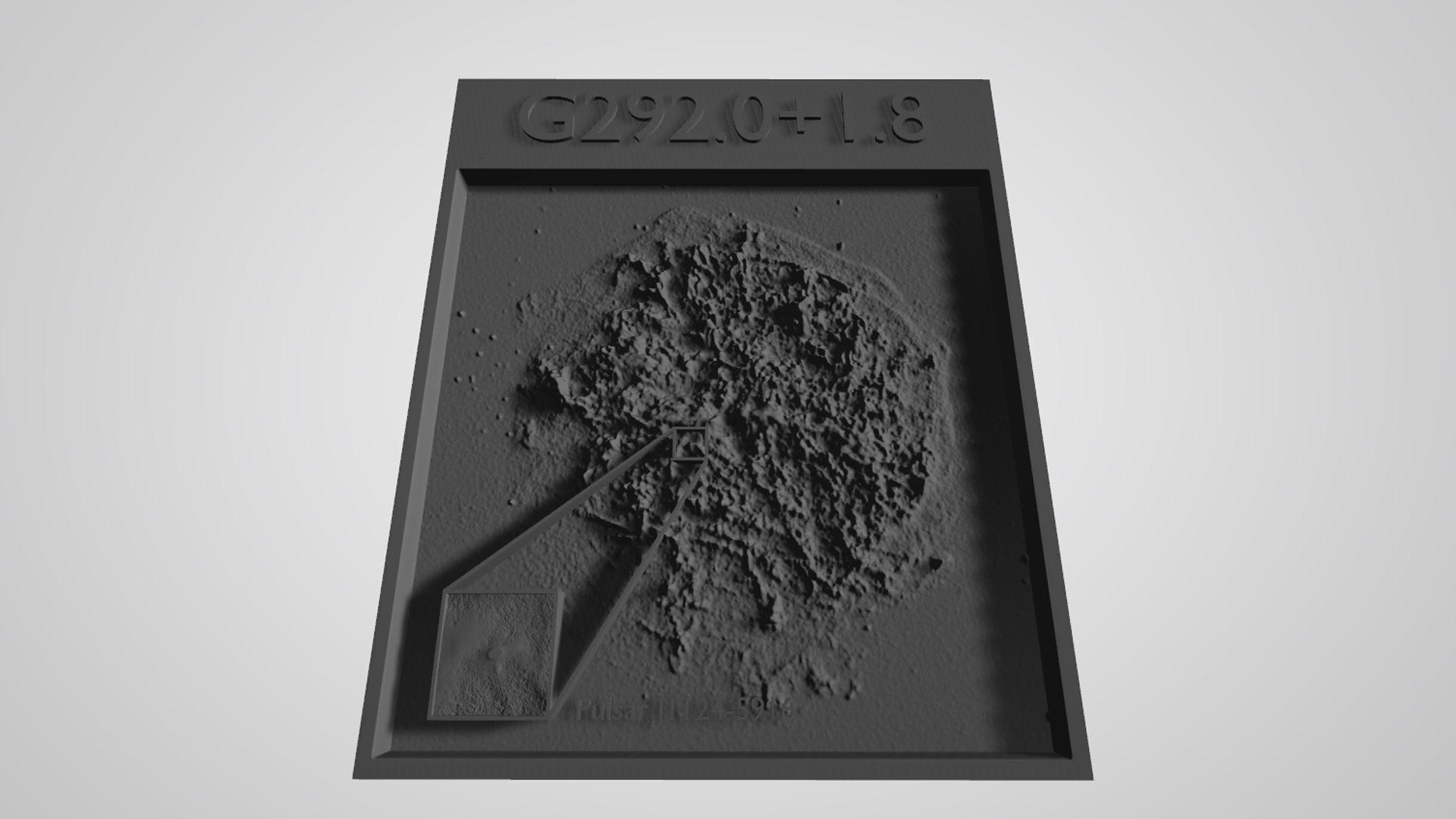
3D Print Credit: NASA/CXC/A. Jubett, using software by Tactile Universe/N. Bonne & C. Krawczyk & Blender
This tactile plate depicts bright glowing quasar H1821+643 powered by a supermassive black hole, as a physical relief map based on the intensity of the X-ray data captured by Chandra. The file for this plate can be downloaded and 3D-printed for learners to touch.
The quasar can be felt at the center of the image and sits in the middle of a hazy cloud. This cloud is hot gas in the cluster of galaxies where the quasar resides, as observed by NASA’s Chandra X-ray Observatory.
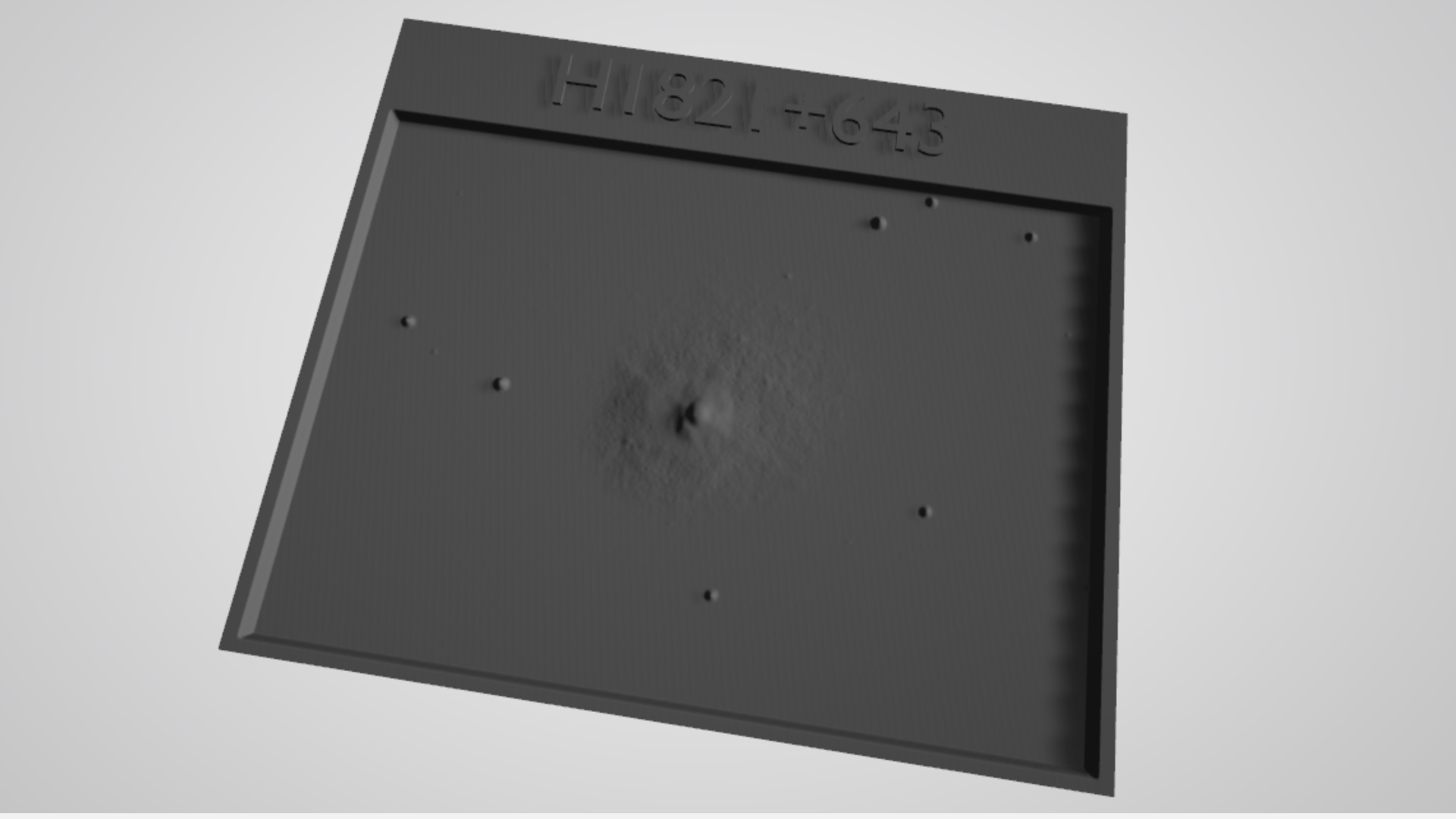
3D Print Credit: NASA/CXC/A. Jubett, using software by Tactile Universe/N. Bonne & C. Krawczyk & Blender
Milky Way
This tactile plate depicts our Milky Way galaxy as a physical relief map based on the intensity of the data captured in optical light. Sagittarius A* is located at the core of the galaxy in the center of the plate. The file for this plate can be downloaded and 3D-printed for learners to touch.
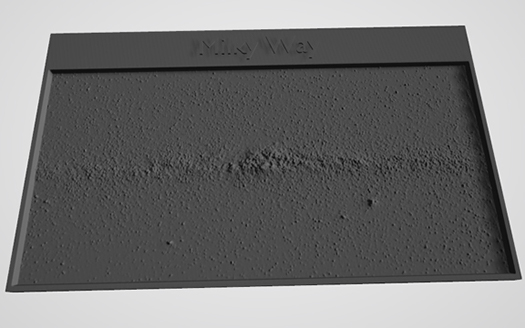
3D Print Credit: NASA/CXC/A. Jubett, K.Arcand et al., using software by Tactile Universe/N. Bonne & C. Krawczyk & Blender; Photo Credit: ESO/S. Brunier
This tactile plate depicts the center of the Milky Way at very close proximity to the central supermassive black hole, Sagittarius A*, as a physical relief map based on the intensity of the radio data captured by the Event Horizon Telescope (EHT). The file for this plate can be downloaded and 3D-printed for learners to touch.
This image showcases Sagittarius A*, the supermassive black hole at the heart of our Milky Way galaxy. Gas in a glowing ring surrounds the black hole’s “event horizon”, a boundary from which nothing can escape. The ring features three bright spots and a fuzzy aura, set against a solid background. The ring is created by light bending in the intense gravity around the black hole at the center, which has a mass some 4 million times greater than that of our Sun.
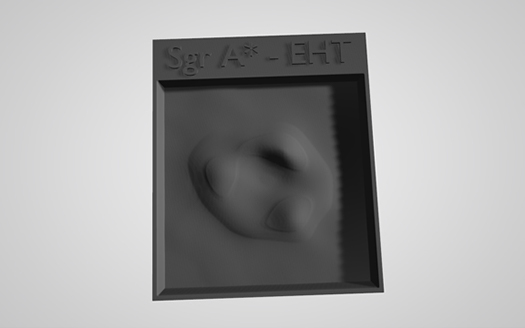
3D Print Credit: NASA/CXC/A. Jubett, K.Arcand et al., using software by Tactile Universe/N. Bonne & C. Krawczyk & Blender; Photo Credit: ESO/S. Brunier
This tactile plate depicts a larger area surrounding the Milky Way’s central supermassive black hole, Sagittarius A*, as a physical relief map based on the intensity of the X-ray data captured by NASA’s Chandra X-ray Observatory. Sagittarius A*, near the center, is marked with an arrow. The file for this plate can be downloaded and 3D-printed for learners to touch.
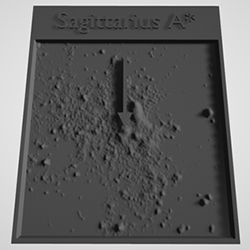
3D Print Credit: NASA/CXC/A. Jubett, K.Arcand et al., using software by Tactile Universe/N. Bonne & C. Krawczyk & Blender; Photo Credit: NASA/CXC/UCLA/Z.Li et al.
This tactile plate depicts NGC 4424, a spiral galaxy, as a physical relief map based on the intensity of the X-ray data captured by Chandra and the optical data captured by Hubble. The file for this plate can be downloaded and 3D-printed for learners to touch.
The spiral galaxy is observed from the side, making the spiral structure less evident, like observing a frisbee only from the side. The center of this galaxy is expected to host a large black hole estimated to contain a mass between about 60,000 and 100,000 Suns. There are also likely to be millions of stellar-mass black holes, which contain between about 5 and 30 solar masses, spread throughout the galaxy.
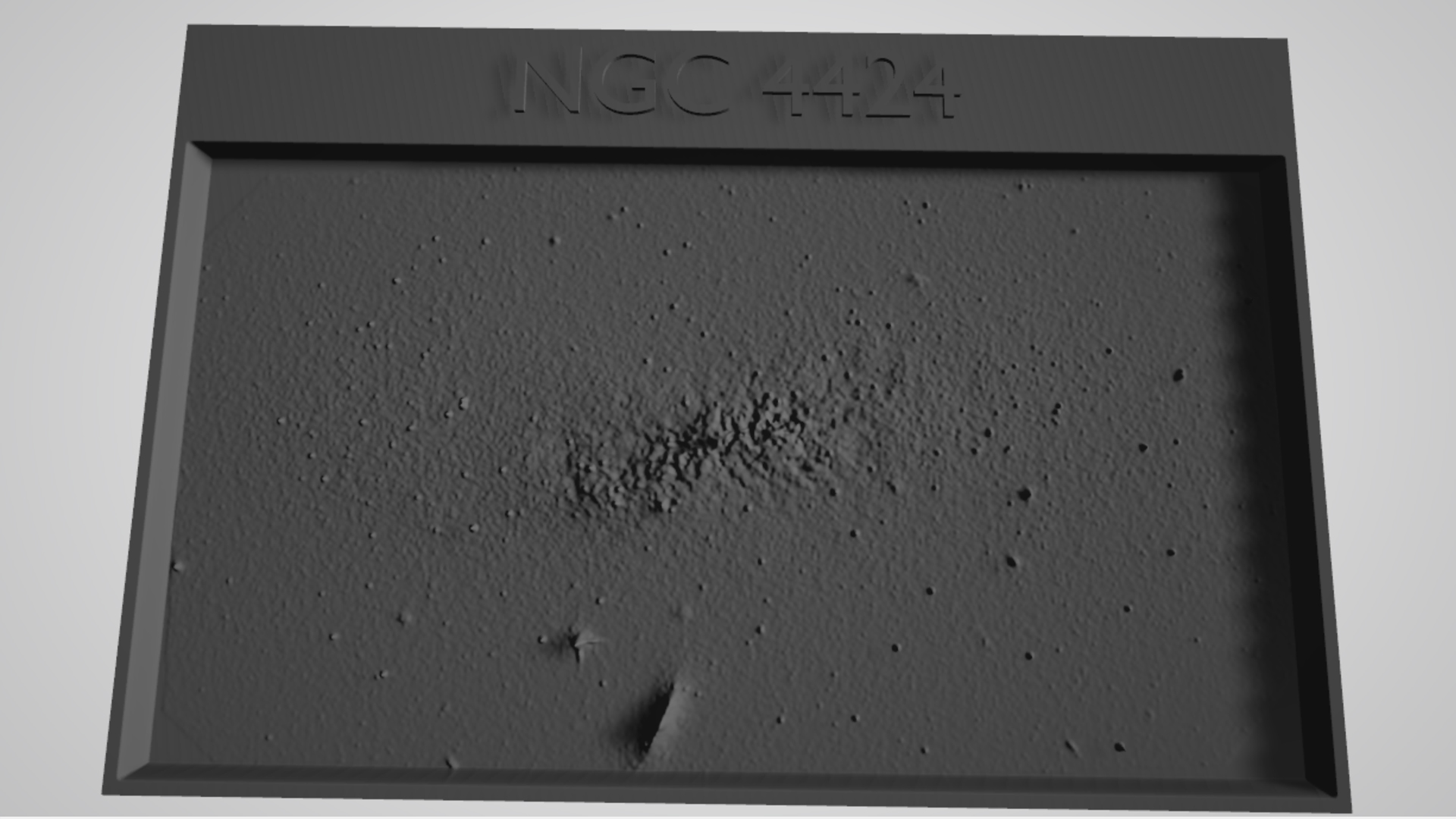
3D Print Credit: NASA/CXC/A. Jubett, using software by Tactile Universe/N. Bonne & C. Krawczyk & Blender
cxcpub@cfa.harvard.edu
617-496-7941
60 Garden Street,
Cambridge, MA 02138 USA
Art Direction/Design: Kristin DiVona
Web Developer: Khajag Mgrdichian
Chandra X-ray Center, Operated for NASA by the Smithsonian Astrophysical Observatory. This site was developed with funding from NASA under contract NAS8-03060 | Privacy | Accessibility
Additional support from NASA's Universe of Learning (UoL). UoL materials are based upon work supported by NASA under award number NNX16AC65A to the Space
Telescope Science Institute, working in partnership with Caltech/IPAC, Jet Propulsion Laboratory, Smithsonian Astrophysical Observatory.

